Inside Aztec
Inside
Aztec
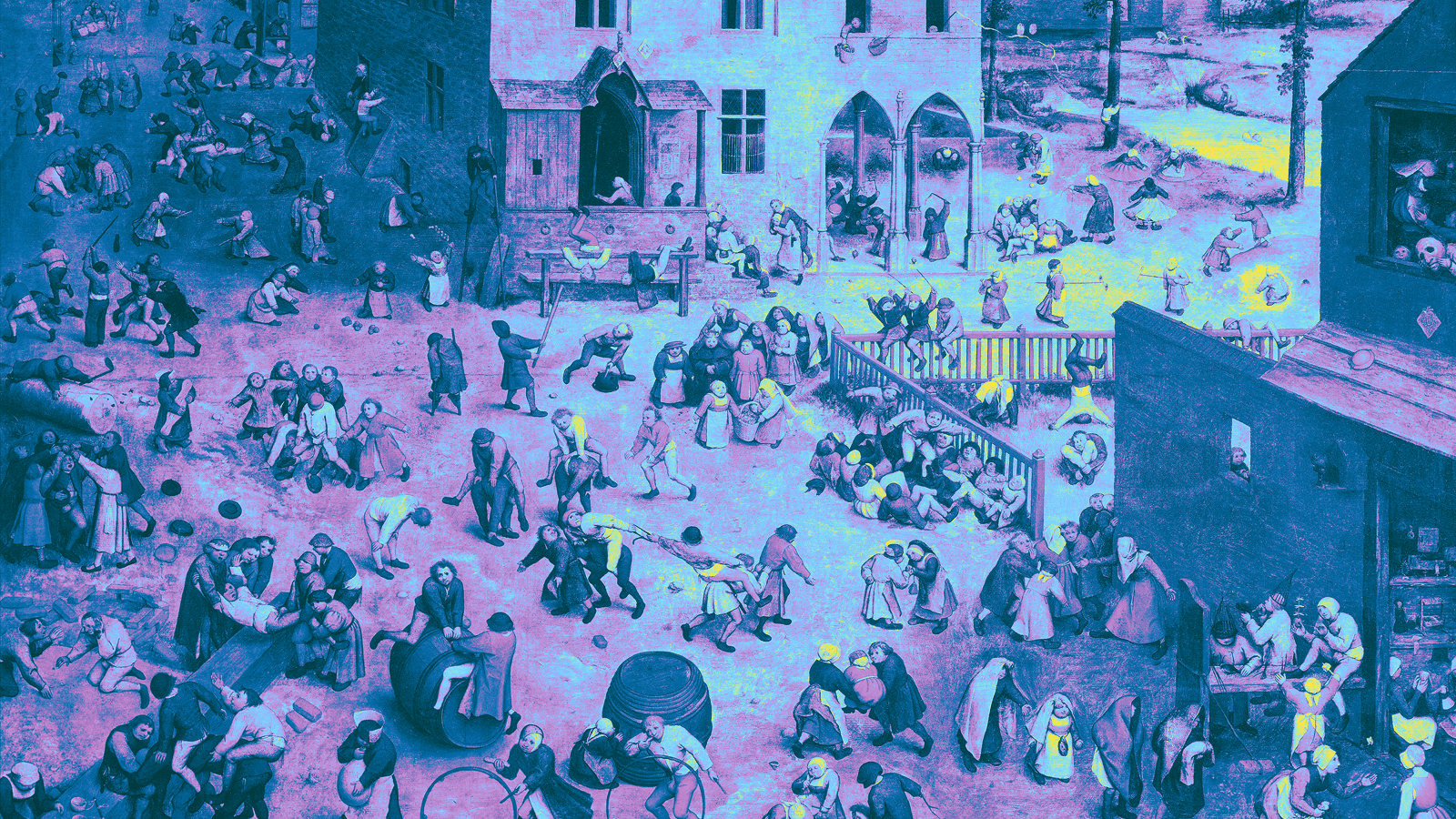

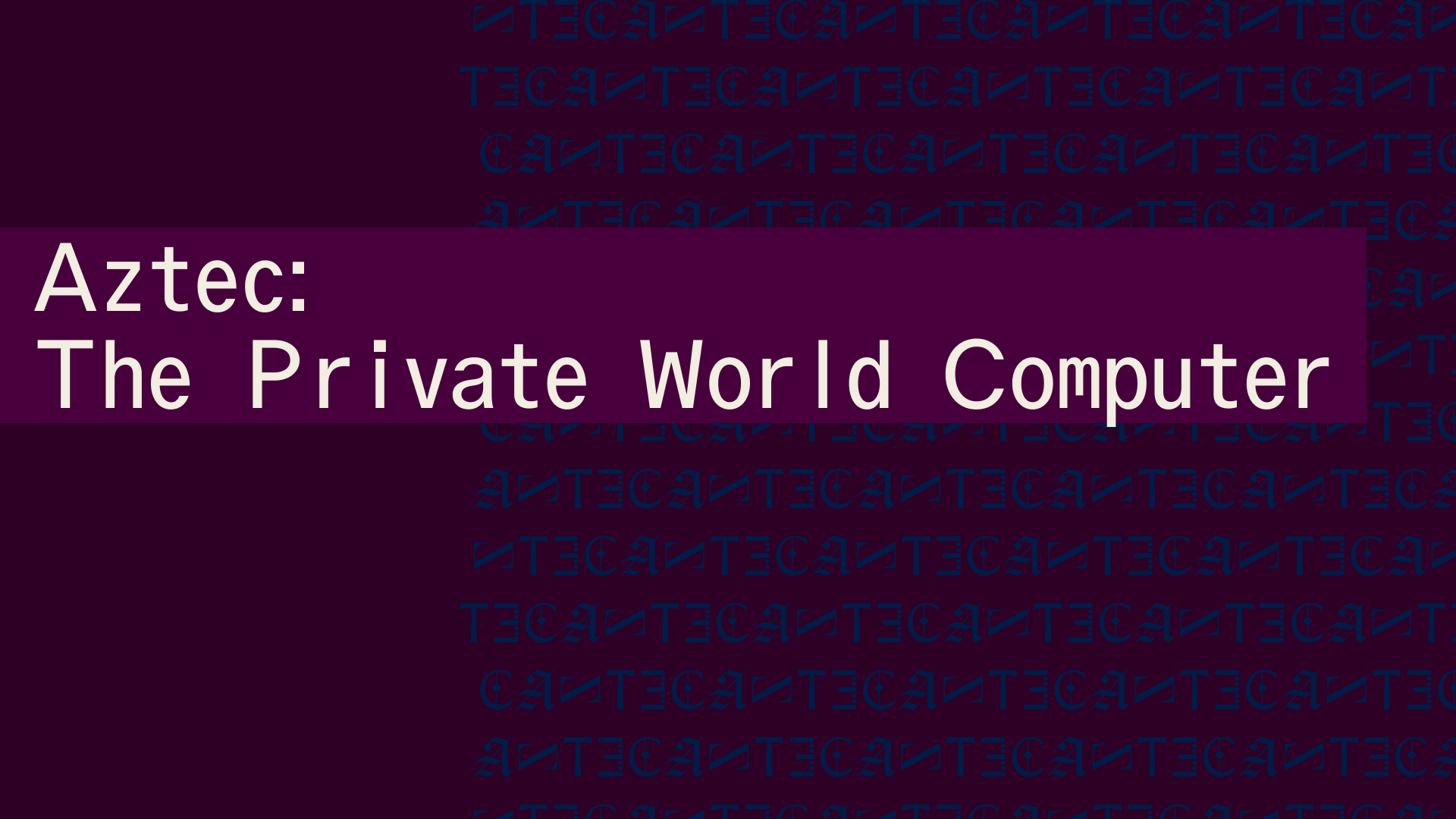
Building a fully decentralized, privacy-preserving network to unlock the next Renaissance.
Privacy has emerged as a major driver for the crypto industry in 2025. We’ve seen the explosion of Zcash, the Ethereum Foundation’s refocusing of PSE, and the launch of Aztec’s testnet with over 24,000 validators powering the network. Many apps have also emerged to bring private transactions to Ethereum and Solana in various ways, and exciting technologies like ZKPassport that privately bring identity on-chain using Noir have become some of the most talked about developments for ushering in the next big movements to the space.
Underpinning all of these developments is the emerging consensus that without privacy, blockchains will struggle to gain real-world adoption.
Without privacy, institutions can’t bring assets on-chain in a compliant way or conduct complex swaps and trades without revealing their strategies. Without privacy, DeFi remains dominated and controlled by advanced traders who can see all upcoming transactions and manipulate the market. Without privacy, regular people will not want to move their lives on-chain for the entire world to see every detail about their every move.
While there's been lots of talk about privacy, few can define it. In this piece we’ll outline the three pillars of privacy and gives you a framework for evaluating the privacy claims of any project.
True privacy rests on three essential pillars: transaction privacy, identity privacy, and computational privacy. It is only when we have all three pillars that we see the emergence of a private world computer.

Transaction privacy means that both inputs and outputs are not viewable by anyone other than the intended participants. Inputs include any asset, value, message, or function calldata that is being sent. Outputs include any state changes or transaction effects, or any transaction metadata caused by the transaction. Transaction privacy is often primarily achieved using a UTXO model (like Zcash or Aztec’s private state tree). If a project has only the option for this pillar, it can be said to be confidential, but not private.
Identity privacy means that the identities of those involved are not viewable by anyone other than the intended participants. This includes addresses or accounts and any information about the identity of the participants, such as tx.origin, msg.sender, or linking one’s private account to public accounts. Identity privacy can be achieved in several ways, including client-side proof generation that keeps all user info on the users’ devices. If a project has only the option for this pillar, it can be said to be anonymous, but not private.
Computation privacy means that any activity that happens is not viewable by anyone other than the intended participants. This includes the contract code itself, function execution, contract address, and full callstack privacy. Additionally, any metadata generated by the transaction is able to be appropriately obfuscated (such as transaction effects, events are appropriately padded, inclusion block number are in appropriate sets). Callstack privacy includes which contracts you call, what functions in those contracts you’ve called, what the results of those functions were, any subsequent functions that will be called after, and what the inputs to the function were. A project must have the option for this pillar to do anything privately other than basic transactions.
Bitcoin ushered in a new paradigm of digital money. As a permissionless, peer-to-peer currency and store of value, it changed the way value could be sent around the world and who could participate. Ethereum expanded this vision to bring us the world computer, a decentralized, general-purpose blockchain with programmable smart contracts.

Given the limitations of running a transparent blockchain that exposes all user activity, accounts, and assets, it was clear that adding the option to preserve privacy would unlock many benefits (and more closely resemble real cash). But this was a very challenging problem. Zcash was one of the first to extend Bitcoin’s functionality with optional privacy, unlocking a new privacy-preserving UTXO model for transacting privately. As we’ll see below, many of the current privacy-focused projects are working on similar kinds of private digital money for Ethereum or other chains.
Now, Aztec is bringing us the final missing piece: a private world computer.
A private world computer is fully decentralized, programmable, and permissionless like Ethereum and has optional privacy at every level. In other words, Aztec is extending all the functionality of Ethereum with optional transaction, identity, and computational privacy. This is the only approach that enables fully compliant, decentralized applications to be built that preserve user privacy, a new design space that we see as ushering in the next Renaissance for the space.
Private digital money emerges when you have the first two privacy pillars covered - transactions and identity - but you don’t have the third - computation. Almost all projects today that claim some level of privacy are working on private digital money. This includes everything from privacy pools on Ethereum and L2s to newly emerging payment L1s like Tempo and Arc that are developing various degrees of transaction privacy
When it comes to digital money, privacy exists on a spectrum. If your identity is hidden but your transactions are visible, that's what we call anonymous. If your transactions are hidden but your identity is known, that's confidential. And when both your identity and transactions are protected, that's true privacy. Projects are working on many different approaches to implement this, from PSE to Payy using Noir, the zkDSL built to make it intuitive to build zk applications using familiar Rust-like syntax.
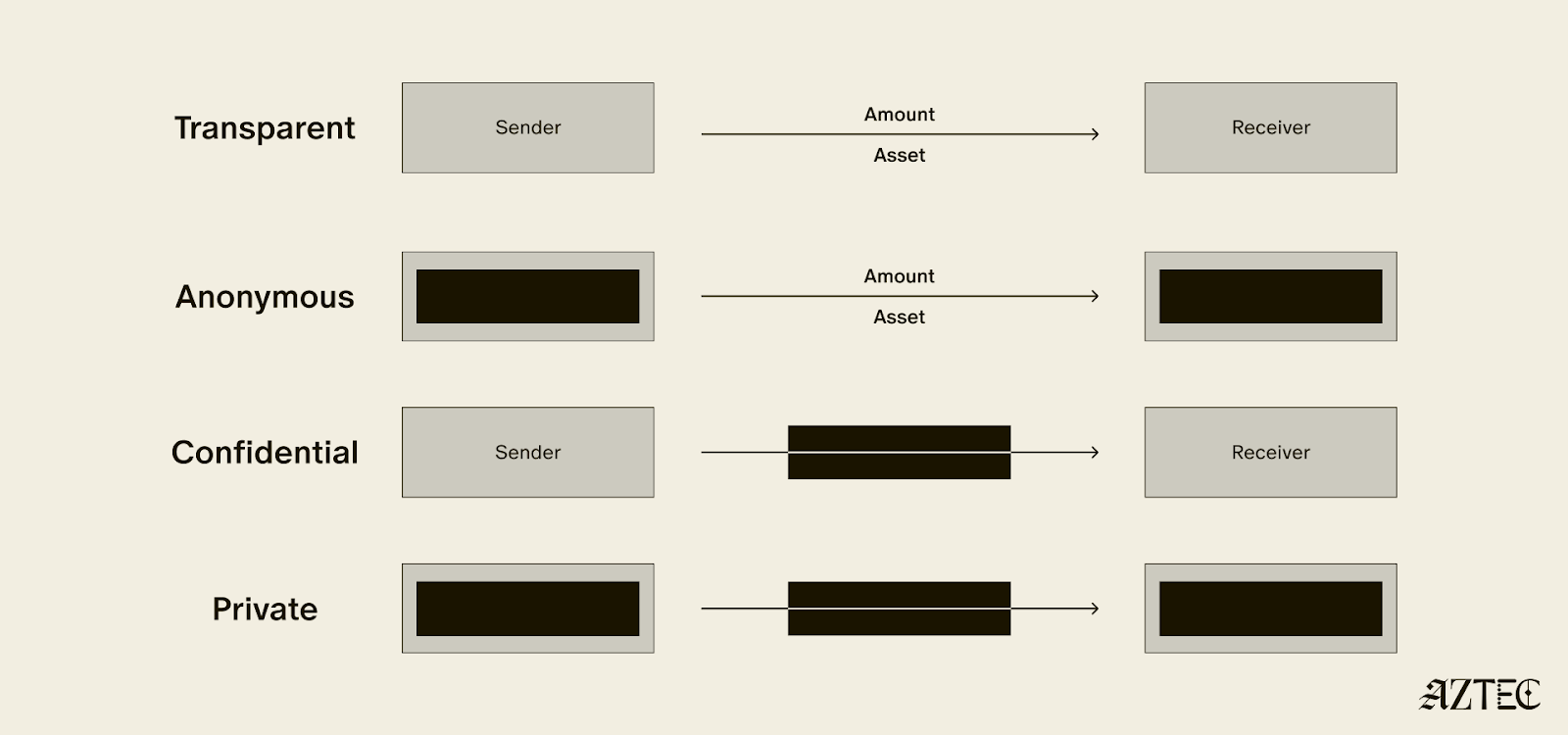
Private digital money is designed to make payments private, but any interaction with more complex smart contracts than a straightforward payment transaction is fully exposed.
What if we also want to build decentralized private apps using smart contracts (usually multiple that talk to each other)? For this, you need all three privacy pillars: transaction, identity, and compute.
If you have these three pillars covered and you have decentralization, you have built a private world computer. Without decentralization, you are vulnerable to censorship, privileged backdoors and inevitable centralized control that can compromise privacy guarantees.
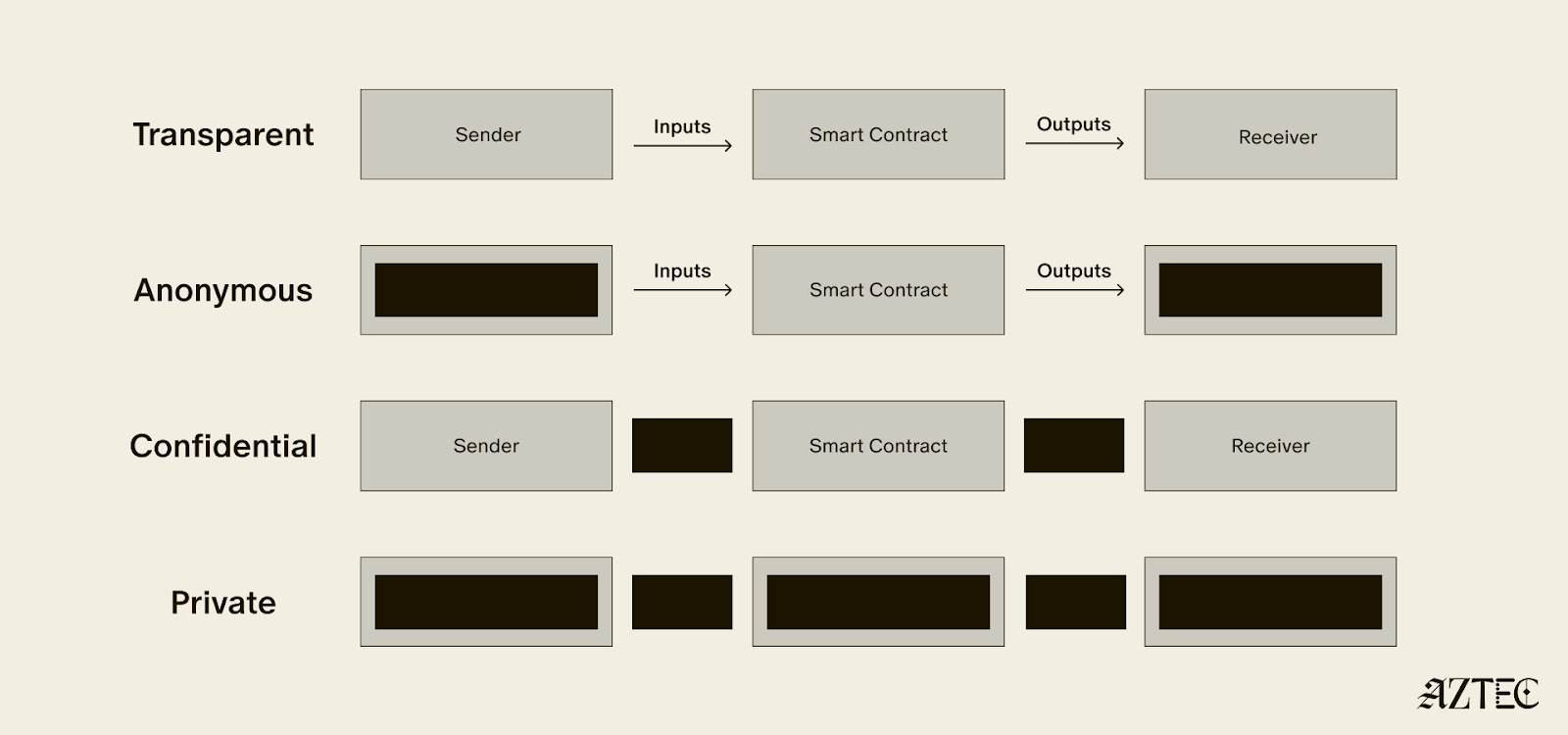
What exactly is a private world computer? A private world computer extends all the functionality of Ethereum with optional privacy at every level, so developers can easily control which aspects they want public or private and users can selectively disclose information. With Aztec, developers can build apps with optional transaction, identity, and compute privacy on a fully decentralized network. Below, we’ll break down the main components of a private world computer.
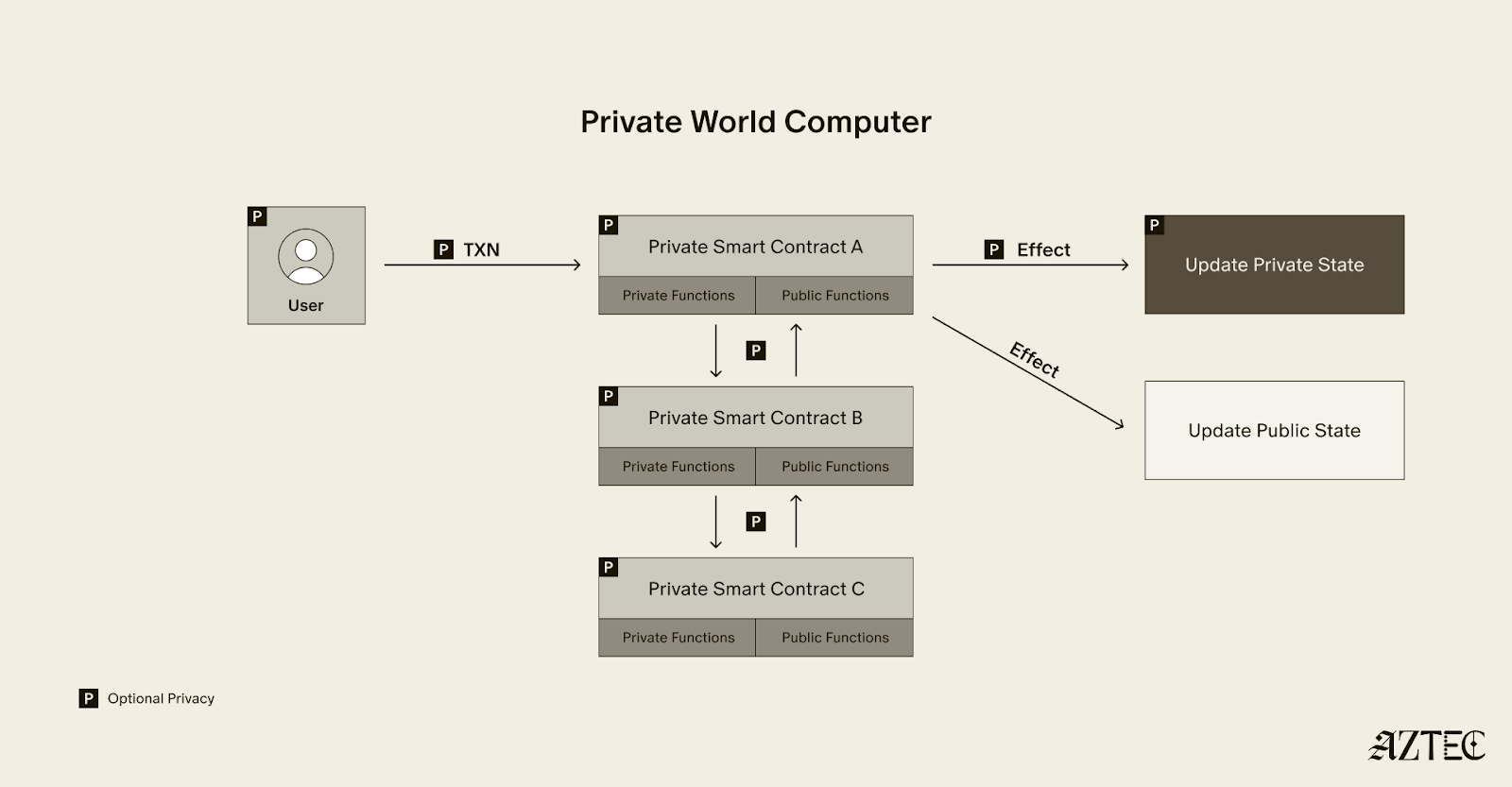
A private world computer is powered by private smart contracts. Private smart contracts have fully optional privacy and also enable seamless public and private function interaction.
Private smart contracts simply extend the functionality of regular smart contracts with added privacy.
As a developer, you can easily designate which functions you want to keep private and which you want to make public. For example, a voting app might allow users to privately cast votes and publicly display the result. Private smart contracts can also interact privately with other smart contracts, without needing to make it public which contracts have interacted.
Transaction: Aztec supports the optionality for fully private inputs, including messages, state, and function calldata. Private state is updated via a private UTXO state tree.
Identity: Using client-side proofs and function execution, Aztec can optionally keep all user info private, including tx.origin and msg.sender for transactions.
Computation: The contract code itself, function execution, and call stack can all be kept private. This includes which contracts you call, what functions in those contracts you’ve called, what the results of those functions were, and what the inputs to the function were.
A decentralized network must be made up of a permissionless network of operators who run the network and decide on upgrades. Aztec is run by a decentralized network of node operators who propose and attest to transactions. Rollup proofs on Aztec are also run by a decentralized prover network that can permissionlessly submit proofs and participate in block rewards. Finally, the Aztec network is governed by the sequencers, who propose, signal, vote, and execute network upgrades.
A private world computer enables the creation of DeFi applications where accounts, transactions, order books, and swaps remain private. Users can protect their trading strategies and positions from public view, preventing front-running and maintaining competitive advantages. Additionally, users can bridge privately into cross-chain DeFi applications, allowing them to participate in DeFi across multiple blockchains while keeping their identity private despite being on an existing transparent blockchain.
This technology makes it possible to bring institutional trading activity on-chain while maintaining the privacy that traditional finance requires. Institutions can privately trade with other institutions globally, without having to touch public markets, enjoying the benefits of blockchain technology such as fast settlement and reduced counterparty risk, without exposing their trading intentions or volumes to the broader market.
Organizations can bring client accounts and assets on-chain while maintaining full compliance. This infrastructure protects on-chain asset trading and settlement strategies, ensuring that sophisticated financial operations remain private. A private world computer also supports private stablecoin issuance and redemption, allowing financial institutions to manage digital currency operations without revealing sensitive business information.
Users have granular control over their privacy settings, allowing them to fine-tune privacy levels for their on-chain identity according to their specific needs. The system enables selective disclosure of on-chain activity, meaning users can choose to reveal certain transactions or holdings to regulators, auditors, or business partners while keeping other information private, meeting compliance requirements.
The shift from transparent blockchains to privacy-preserving infrastructure is the foundation for bringing the next billion users on-chain. Whether you're a developer building the future of private DeFi, an institution exploring compliant on-chain solutions, or simply someone who believes privacy is a fundamental right, now is the time to get involved.
Follow Aztec on X to stay updated on the latest developments in private smart contracts and decentralized privacy technology. Ready to contribute to the network? Run a node and help power the private world computer.
The next Renaissance is here, and it’s being powered by the private world computer.
Special thanks to Santiago Palladino, Phil Windle, Alex Gherghisan, and Mitch Tracy for technical updates and review.
On September 17th, 2025, a new network upgrade was deployed, making Aztec more secure and flexible for home stakers. This upgrade, shipped with all the features needed for a fully decentralized network launch, includes a completely redesigned slashing system that allows inactive or malicious operators to be removed, and does not penalize home stakers for short outages.
With over 23,000 operators running validators across 6 continents (in a variety of conditions), it is critical not to penalize nodes that temporarily drop due to internet connectivity issues. This is because users of the network are also found across the globe, some of whom might have older phones. A significant effort was put into shipping a low-memory proving mode that allows older mobile devices to send transactions and use privacy-preserving apps.
The network was successfully deployed, and all active validators on the old testnet were added to the queue of the new testnet. This manual migration was only necessary because major upgrades to the governance contracts had gone in since the last testnet was deployed. The new testnet started producing blocks after the queue started to be “flushed,” moving validators into the rollup. Because the network is fully decentralized, the initial flush could have been called by anyone. The network produced ~2k blocks before an invalid block made it to the chain and temporarily stalled block production. Block production is now restored and the network is healthy. This post explains what caused the issue and provides an update on the current status of the network.
Note: if you are a network operator, you must upgrade to version 2.0.3 and restart your node to participate in the latest testnet. If you want to run a node, it’s easy to get started.
This upgrade was a team-wide effort that optimized performance and implemented all the mechanisms needed to launch Aztec as a fully decentralized network from day 1.
With these updates in place, we’re ready to test a feature-complete network.
As mentioned above, block production started when someone called the flush function and a minimum number of operators from the queue were let into the validator set.
Shortly thereafter, while testing the network, a member of the Aztec Labs team spun up a “bad” sequencer that produced an invalid block proposal. Specifically, one of the state trees in the proposal was tampered with.

The expectation was that this would be detected immediately and the block rejected. Instead, a bug was discovered in the validator code where the invalid block proposal wasn't checked thoroughly enough. In effect, the proposal got enough attestations, so it was posted to the rollup. Due to extra checks in the nodes, when the nodes pulled the invalid block from Ethereum, they detected the tampered tree and refused to sync it. This is a good outcome as it prevented the attack. Additionally, prover nodes refused to prove the epoch containing the invalid block. This allowed the rollup to prune the entire bad epoch away. After the prune, the invalid state was reset to the last known good block.
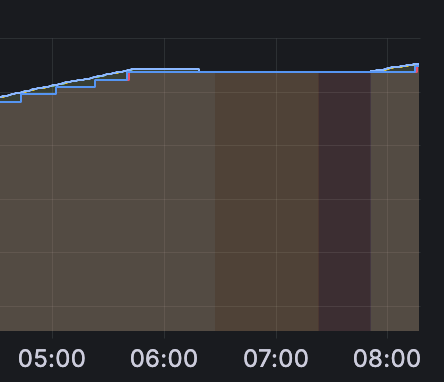
The prune revealed another, smaller bug, where, after a failed block sync, a prune does not get processed correctly, requiring a node restart to clear up. This led to a 90-minute outage from the moment the block proposal was posted until the testnet recovered. The time was equally split between waiting for pruning to happen and for the nodes to restart in order to process the prune.
Validators were correctly re-executing all transactions in the block proposals and verifying that the world state root matched the one in the block proposal, but they failed to check that intermediate tree roots, which are included in the proposal and posted to the rollup contract on L1, were also correct. The attack tweaked one of these intermediate roots while proposing a correct world state root, so it went unnoticed by the attestors.
As mentioned above, even though the block made it through the initial attestation and was posted to L1, the invalid block was caught by the validators, and the entire epoch was never proven as provers refused to generate a proof for the inconsistent state.
A fix was pushed that resolved this issue and ensured that invalid block proposals would be caught and rejected. A second fix was pushed that ensures inconsistent state is removed from the uncommitted cache of the world state.

Block production is currently running smoothly, and the network health has been restored.
Operators who had previously upgraded to version 2.0.3 will need to restart their nodes. Any operator who has not upgraded to 2.0.3 should do so immediately.
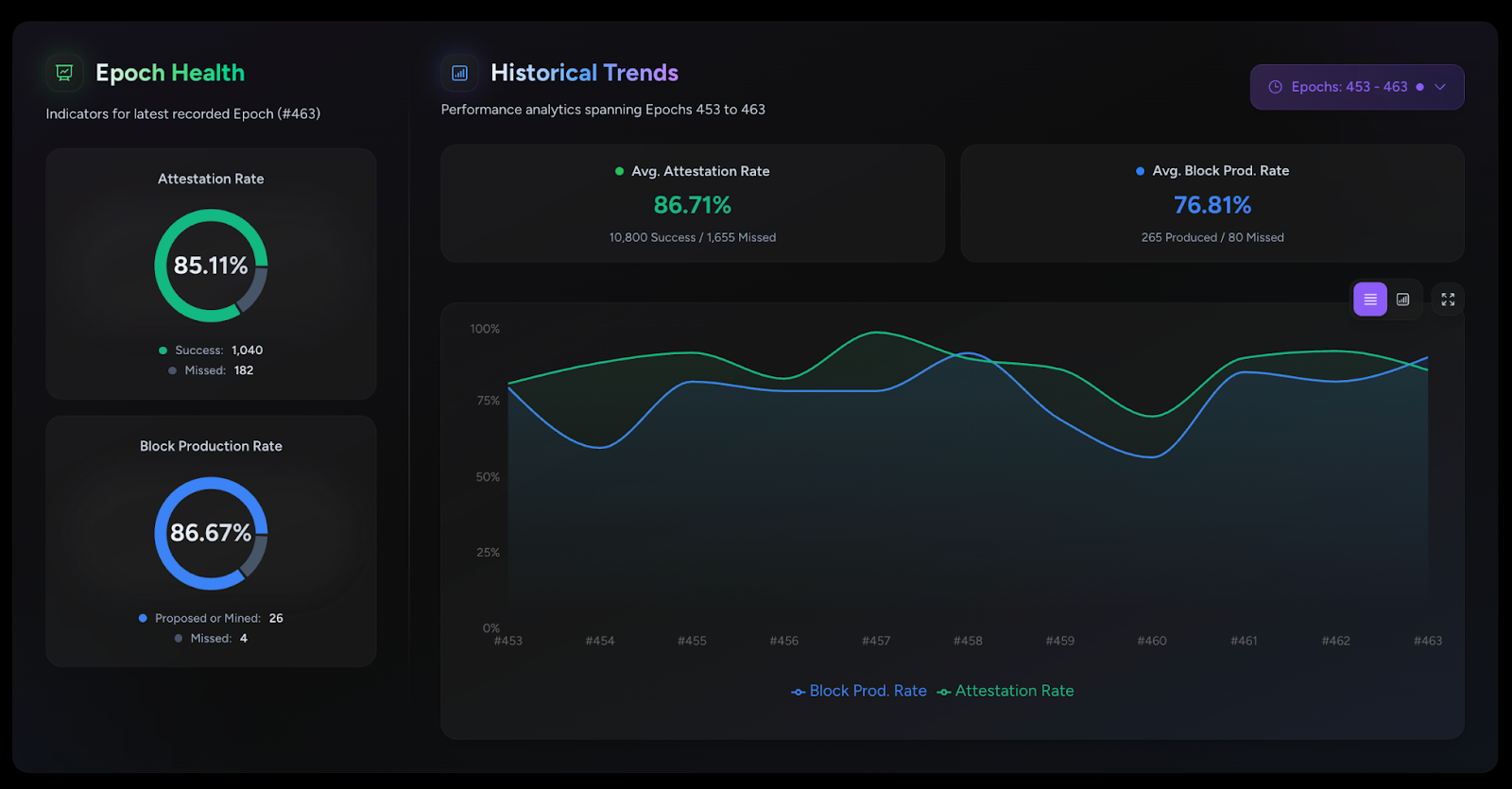
Slashing has also been functioning as expected. Below you can see the slashing signals for each round. A single signal can contain votes for multiple validators, but a validator's attester needs to receive 65 votes to be slashed.
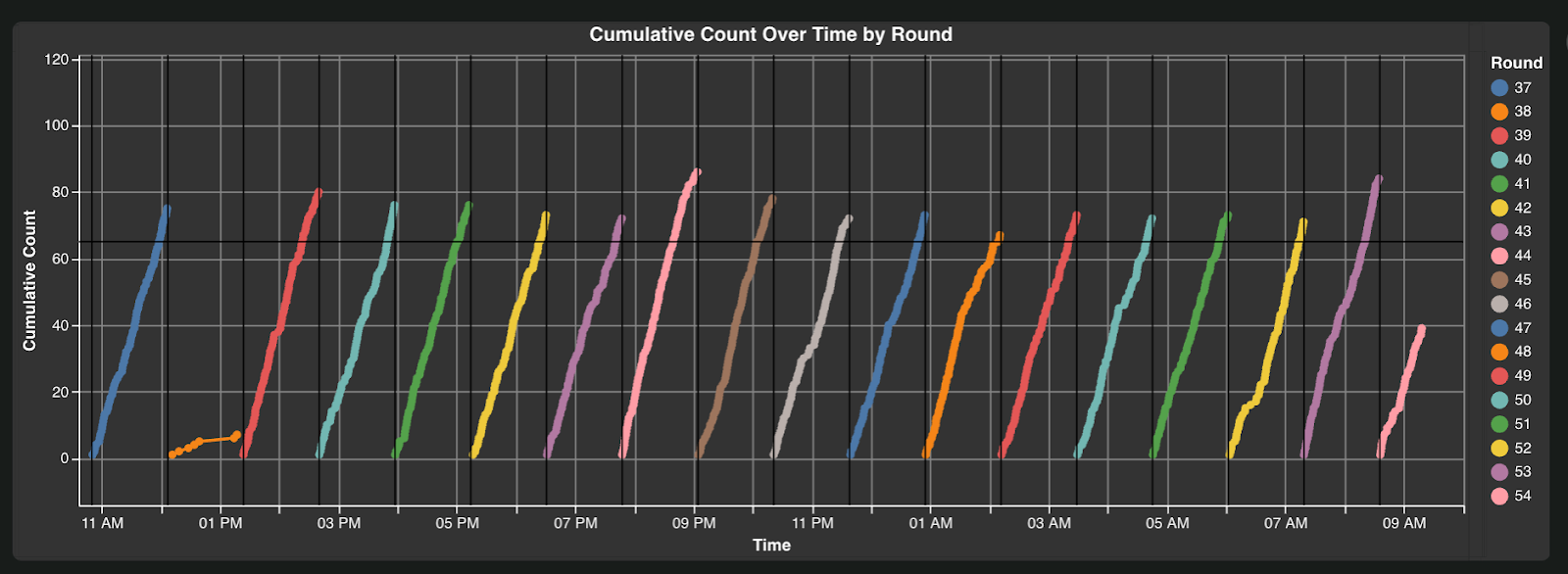
Join us this Thursday, September 25, 2025, at 4 PM CET on the Discord Town Hall to hear more about the 2.0.3 upgrade. To stay up to date with the latest updates for network operators, join the Aztec Discord and follow Aztec on X.
Payy, a privacy-focused payment network, just rewrote its entire ZK architecture from Halo2 to Noir while keeping its network live, funds safe, and users happy.
Code that took months to write now takes weeks (with MVPs built in as little as 30 minutes). Payy’s codebase shrank from thousands of lines to 250, and now their entire engineering team can actually work on its privacy infra.
This is the story of how they transformed their ZK ecosystem from one bottlenecked by a single developer to a system their entire team can modify and maintain.

Eighteen months ago, Payy faced a deceptively simple requirement: build a privacy-preserving payment network that actually works on phones. That requires client-side proving.
"Anyone who tells you they can give you privacy without the proof being on the phone is lying to you," Calum Moore - Payy's Technical Lead - states bluntly.
To make a private, mobile network work, they needed:
To start, the team evaluated available ZK stacks through their zkbench framework:
STARKs (e.g., RISC Zero): Memory requirements made them a non-starter on mobile. Large proof sizes are unsuitable for mobile data transmission.
Circom with Groth16: Required trusted setup ceremonies for each circuit update. It had “abstracted a bit too early” and, as a result, is not high-level enough to develop comfortably, but not low-level enough for controls and optimizations, said Calum.
Halo2: Selected based on existing production deployments (ZCash, Scroll), small proof sizes, and an existing Ethereum verifier. As Calum admitted with the wisdom of hindsight: “Back a year and a half ago, there weren’t any other real options.”
Halo2 delivered on its promises: Payy successfully launched its network. But cracks started showing almost immediately.
First, they had to write their own chips from scratch. Then came the real fun: if statements.
"With Halo2, I'm building a chip, I'm passing this chip in... It's basically a container chip, so you'd set the value to zero or one depending on which way you want it to go. And, you'd zero out the previous value if you didn't want it to make a difference to the calculation," Calum explained, “when I’m writing in Noir, I just write ‘if’. "
With Halo2, writing an if statement (programming 101) required building custom chip infra.
Binary decomposition, another fundamental operation for rollups, meant more custom chips. The Halo2 implementation quickly grew to thousands of lines of incomprehensible code.
And only Calum could touch any of it.
The Bottleneck
"It became this black box that no one could touch, no one could reason about, no one could verify," he recalls. "Obviously, we had it audited, and we were confident in that. But any changes could only be done by me, could only be verified by me or an auditor."
In engineering terms, this is called a bus factor of one: if Calum got hit by a bus (or took a vacation to Argentina), Payy's entire proving system would be frozen. "Those circuits are open source," Calum notes wryly, "but who's gonna be able to read the Halo2 circuits? Nobody."
During a launch event in Argentina, "I was like, oh, I'll check out Noir again. See how it's going," Calum remembers. He'd been tracking Noir's progress for months, occasionally testing it out, waiting for it to be reliable.
"I wrote basically our entire client-side proof in about half an hour in Noir. And it probably took me - I don't know, three weeks to write that proof originally in Halo2."
Calum recreated Payy's client-side proof in Noir in 30 minutes. And when he tested the proving speed, without any optimization, they were seeing 2x speed improvements.
"I kind of internally… didn't want to tell my cofounder Sid that I'd already made my decision to move to Noir," Calum admits. "I hadn't broken it to him yet because it's hard to justify rewriting your proof system when you have a deployed network with a bunch of money already on the network and a bunch of users."
Convincing a team to rewrite the core of a live financial network takes some evidence. The technical evaluation of Noir revealed improvements across every metric:
Proof Generation Time: Sub-0.5 second proof generation on iPhones. "We're obsessive about performance," Calum notes (they’re confident they can push it even further).
Code Complexity: Their entire ZK implementation compressed from thousands of lines of Halo2 to just 250 lines of Noir code. "With rollups, the logic isn't complex—it's more about the preciseness of the logic," Calum explains.
Composability: In Halo2, proof aggregation required hardwiring specific verifiers for each proof type. Noir offers a general-purpose verifier that accepts any proof of consistent size.
"We can have 100 different proving systems, which are hyper-efficient for the kind of application that we're doing," Calum explains. "Have them all aggregated by the same aggregation proof, and reason about whatever needs to be."
Initially, the goal was to "completely mirror our Halo2 proofs": no new features. This conservative approach meant they could verify correctness while maintaining a live network.
The migration preserved Payy's production architecture:
"If you have your proofs in Noir, any person who understands even a little bit about logic or computers can go in and say, 'okay, I can kinda see what's happening here'," Calum notes.
The audit process completely transformed. With Halo2: "The auditors that are available to audit Halo2 are few and far between."
With Noir: "You could have an auditor that had no Noir experience do at least a 95% job."
Why? Most audit issues are logic errors, not ZK-specific bugs. When auditors can read your code, they find real problems instead of getting lost in implementation details.
Halo2: Binary decomposition
Payy’s previous 383 line implementation of binary decomposition can be viewed here (pkg/zk-circuits/src/chips/binary_decomposition.rs).
Payy’s previous binary decomposition implementation
Meanwhile, binary decomposition is handled in Noir with the following single line.
pub fn to_le_bits<let N: u32>(self: Self) -> [u1; N]
(Source)
With Noir's composable proof system, Payy can now build specialized provers for different operations, each optimized for its specific task.
"If statements are horrendous in SNARKs because you pay the cost of the if statement regardless of its run," Calum explains. But with Noir's approach, "you can split your application logic into separate proofs, and run whichever proof is for the specific application you're looking for."
Instead of one monolithic proof trying to handle every case, you can have specialized proofs, each perfect for its purpose.
"I fell a little bit in love with Halo2," Calum admits, "maybe it's Stockholm syndrome where you're like, you know, it's a love-hate relationship, and it's really hard. But at the same time, when you get a breakthrough with it, you're like, yes, I feel really good because I'm basically writing assembly-level ZK proofs."
“But now? I just write ‘if’.”
Technical Note: While "migrating from Halo2 to Noir" is shorthand that works for this article, technically Halo2 is an integrated proving system where circuits must be written directly in Rust using its constraint APIs, while Noir is a high-level language that compiles to an intermediate representation and can use various proving backends. Payy specifically moved from writing circuits in Halo2's low-level constraint system to writing them in Noir's high-level language, with Barretenberg (UltraHonk) as their proving backend.
Both tools ultimately enable developers to write circuits and generate proofs, but Noir's modular architecture separates circuit logic from the proving system - which is what made Payy's circuits so much more accessible to their entire team, and now allows them to swap out their proving system with minimal effort as proving systems improve.
Payy's code is open source and available for developers looking to learn from their implementation.
After eight years of solving impossible problems, the next renaissance is here.
We’re at a major inflection point, with both our tech and our builder community going through growth spurts. The purpose of this rebrand is simple: to draw attention to our full-stack privacy-native network and to elevate the rich community of builders who are creating a thriving ecosystem around it.
For eight years, we’ve been obsessed with solving impossible challenges. We invented new cryptography (Plonk), created an intuitive programming language (Noir), and built the first decentralized network on Ethereum where privacy is native rather than an afterthought.
It wasn't easy. But now, we're finally bringing that powerful network to life. Testnet is live with thousands of active users and projects that were technically impossible before Aztec.
Our community evolution mirrors our technical progress. What started as an intentionally small, highly engaged group of cracked developers is now welcoming waves of developers eager to build applications that mainstream users actually want and need.
A brand is more than aesthetics—it's a mental model that makes Aztec's spirit tangible.
Renaissance means "rebirth"—and that's exactly what happens when developers gain access to privacy-first infrastructure. We're witnessing the emergence of entirely new application categories, business models, and user experiences.
The faces of this renaissance are the builders we serve: the entrepreneurs building privacy-preserving DeFi, the activists building identity systems that protect user privacy, the enterprise architects tokenizing real-world assets, and the game developers creating experiences with hidden information.
This next renaissance isn't just about technology—it's about the ethos behind the build. These aren't just our values. They're the shared DNA of every builder pushing the boundaries of what's possible on Aztec.
Agency: It’s what everyone deserves, and very few truly have: the ability to choose and take action for ourselves. On the Aztec Network, agency is native
Genius: That rare cocktail of existential thirst, extraordinary brilliance, and mind-bending creation. It’s fire that fuels our great leaps forward.
Integrity: It’s the respect and compassion we show each other. Our commitment to attacking the hardest problems first, and the excellence we demand of any solution.
Obsession: That highly concentrated insanity, extreme doggedness, and insatiable devotion that makes us tick. We believe in a different future—and we can make it happen, together.
Just as our technology bridges different eras of cryptographic innovation, our new visual identity draws from multiple periods of human creativity and technological advancement.
Our new wordmark embodies the diversity of our community and the permissionless nature of our network. Each letter was custom-drawn to reflect different pivotal moments in human communication and technological progress.
Together, these letters tell the story of human innovation: each era building on the last, each breakthrough enabling the next renaissance. And now, we're building the infrastructure for the one that's coming.
We evolved our original icon to reflect this new chapter while honoring our foundation. The layered diamond structure tells the story:
The architecture echoes a central plaza—the Roman forum, the Greek agora, the English commons, the American town square—places where people gather, exchange ideas, build relationships, and shape culture. It's a fitting symbol for the infrastructure enabling the next leap in human coordination and creativity.
From the Mughal and Edo periods to the Flemish and Italian Renaissance, our brand imagery draws from different cultures and eras of extraordinary human flourishing—periods when science, commerce, culture and technology converged to create unprecedented leaps forward. These visuals reflect both the universal nature of the Renaissance and the global reach of our network.
But we're not just celebrating the past —we're creating the future: the infrastructure for humanity's next great creative and technological awakening, powered by privacy-native blockchain technology.
Join us to ask questions, learn more and dive into the lore.
Join Our Discord Town Hall. September 4th at 8 AM PT, then every Thursday at 7 AM PT. Come hear directly from our team, ask questions, and connect with other builders who are shaping the future of privacy-first applications.
Take your stance on privacy. Visit the privacy glyph generator to create your custom profile pic and build this new world with us.
Stay Connected. Visit the new website and to stay up-to-date on all things Noir and Aztec, make sure you’re following along on X.
The next renaissance is what you build on Aztec—and we can't wait to see what you'll create.
Aztec’s Public Testnet launched in May 2025.
Since then, we’ve been obsessively working toward our ultimate goal: launching the first fully decentralized privacy-preserving layer-2 (L2) network on Ethereum. This effort has involved a team of over 70 people, including world-renowned cryptographers and builders, with extensive collaboration from the Aztec community.
To make something private is one thing, but to also make it decentralized is another. Privacy is only half of the story. Every component of the Aztec Network will be decentralized from day one because decentralization is the foundation that allows privacy to be enforced by code, not by trust. This includes sequencers, which order and validate transactions, provers, which create privacy-preserving cryptographic proofs, and settlement on Ethereum, which finalizes transactions on the secure Ethereum mainnet to ensure trust and immutability.
Strong progress is being made by the community toward full decentralization. The Aztec Network now includes nearly 1,000 sequencers in its validator set, with 15,000 nodes spread across more than 50 countries on six continents. With this globally distributed network in place, the Aztec Network is ready for users to stress test and challenge its resilience.
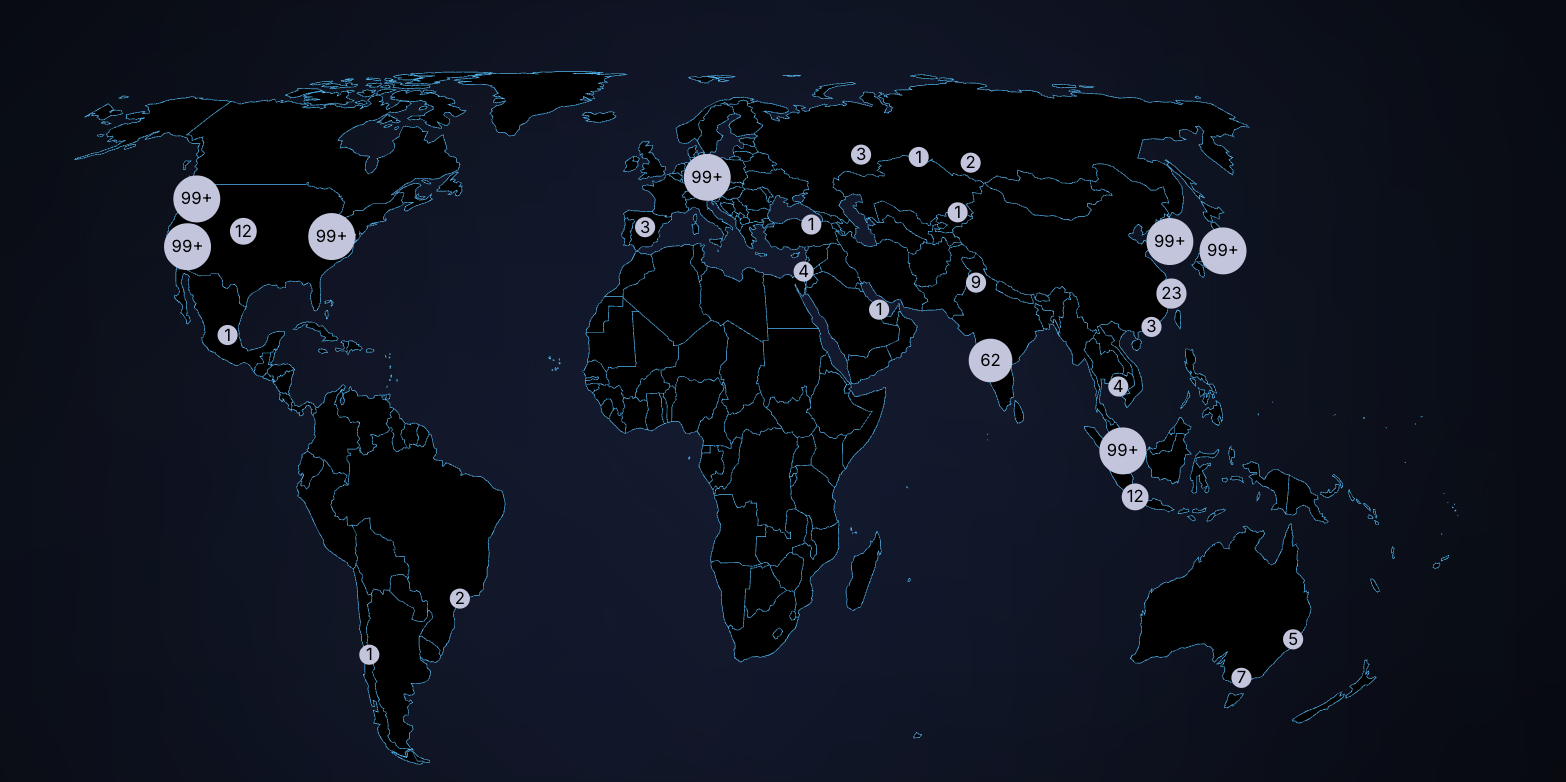
We're now entering a new phase: the Adversarial Testnet. This stage will test the resilience of the Aztec Testnet and its decentralization mechanisms.
The Adversarial Testnet introduces two key features: slashing, which penalizes validators for malicious or negligent behavior in Proof-of-Stake (PoS) networks, and a fully decentralized governance mechanism for protocol upgrades.
This phase will also simulate network attacks to test its ability to recover independently, ensuring it could continue to operate even if the core team and servers disappeared (see more on Vitalik’s “walkaway test” here). It also opens the validator set to more people using ZKPassport, a private identity verification app, to verify their identity online.
The Aztec Network testnet is decentralized, run by a permissionless network of sequencers.
The slashing upgrade tests one of the most fundamental mechanisms for removing inactive or malicious sequencers from the validator set, an essential step toward strengthening decentralization.
Similar to Ethereum, on the Aztec Network, any inactive or malicious sequencers will be slashed and removed from the validator set. Sequencers will be able to slash any validator that makes no attestations for an entire epoch or proposes an invalid block.
Three slashes will result in being removed from the validator set. Sequencers may rejoin the validator set at any time after getting slashed; they just need to rejoin the queue.
In addition to testing network resilience when validators go offline and evaluating the slashing mechanisms, the Adversarial Testnet will also assess the robustness of the network’s decentralized governance during protocol upgrades.
Adversarial Testnet introduces changes to Aztec Network’s governance system.
Sequencers now have an even more central role, as they are the sole actors permitted to deposit assets into the Governance contract.
After the upgrade is defined and the proposed contracts are deployed, sequencers will vote on and implement the upgrade independently, without any involvement from Aztec Labs and/or the Aztec Foundation.
Starting today, you can join the Adversarial Testnet to help battle-test Aztec’s decentralization and security. Anyone can compete in six categories for a chance to win exclusive Aztec swag, be featured on the Aztec X account, and earn a DappNode. The six challenge categories include:
Performance will be tracked using Dashtec, a community-built dashboard that pulls data from publicly available sources. Dashtec displays a weighted score of your validator performance, which may be used to evaluate challenges and award prizes.
The dashboard offers detailed insights into sequencer performance through a stunning UI, allowing users to see exactly who is in the current validator set and providing a block-by-block view of every action taken by sequencers.
To join the validator set and start tracking your performance, click here. Join us on Thursday, July 31, 2025, at 4 pm CET on Discord for a Town Hall to hear more about the challenges and prizes. Who knows, we might even drop some alpha.
To stay up-to-date on all things Noir and Aztec, make sure you’re following along on X.
Privacy has emerged as a major driver for the crypto industry in 2025. We’ve seen the explosion of Zcash, the Ethereum Foundation’s refocusing of PSE, and the launch of Aztec’s testnet with over 24,000 validators powering the network. Many apps have also emerged to bring private transactions to Ethereum and Solana in various ways, and exciting technologies like ZKPassport that privately bring identity on-chain using Noir have become some of the most talked about developments for ushering in the next big movements to the space.
Underpinning all of these developments is the emerging consensus that without privacy, blockchains will struggle to gain real-world adoption.
Without privacy, institutions can’t bring assets on-chain in a compliant way or conduct complex swaps and trades without revealing their strategies. Without privacy, DeFi remains dominated and controlled by advanced traders who can see all upcoming transactions and manipulate the market. Without privacy, regular people will not want to move their lives on-chain for the entire world to see every detail about their every move.
While there's been lots of talk about privacy, few can define it. In this piece we’ll outline the three pillars of privacy and gives you a framework for evaluating the privacy claims of any project.
True privacy rests on three essential pillars: transaction privacy, identity privacy, and computational privacy. It is only when we have all three pillars that we see the emergence of a private world computer.

Transaction privacy means that both inputs and outputs are not viewable by anyone other than the intended participants. Inputs include any asset, value, message, or function calldata that is being sent. Outputs include any state changes or transaction effects, or any transaction metadata caused by the transaction. Transaction privacy is often primarily achieved using a UTXO model (like Zcash or Aztec’s private state tree). If a project has only the option for this pillar, it can be said to be confidential, but not private.
Identity privacy means that the identities of those involved are not viewable by anyone other than the intended participants. This includes addresses or accounts and any information about the identity of the participants, such as tx.origin, msg.sender, or linking one’s private account to public accounts. Identity privacy can be achieved in several ways, including client-side proof generation that keeps all user info on the users’ devices. If a project has only the option for this pillar, it can be said to be anonymous, but not private.
Computation privacy means that any activity that happens is not viewable by anyone other than the intended participants. This includes the contract code itself, function execution, contract address, and full callstack privacy. Additionally, any metadata generated by the transaction is able to be appropriately obfuscated (such as transaction effects, events are appropriately padded, inclusion block number are in appropriate sets). Callstack privacy includes which contracts you call, what functions in those contracts you’ve called, what the results of those functions were, any subsequent functions that will be called after, and what the inputs to the function were. A project must have the option for this pillar to do anything privately other than basic transactions.
Bitcoin ushered in a new paradigm of digital money. As a permissionless, peer-to-peer currency and store of value, it changed the way value could be sent around the world and who could participate. Ethereum expanded this vision to bring us the world computer, a decentralized, general-purpose blockchain with programmable smart contracts.

Given the limitations of running a transparent blockchain that exposes all user activity, accounts, and assets, it was clear that adding the option to preserve privacy would unlock many benefits (and more closely resemble real cash). But this was a very challenging problem. Zcash was one of the first to extend Bitcoin’s functionality with optional privacy, unlocking a new privacy-preserving UTXO model for transacting privately. As we’ll see below, many of the current privacy-focused projects are working on similar kinds of private digital money for Ethereum or other chains.
Now, Aztec is bringing us the final missing piece: a private world computer.
A private world computer is fully decentralized, programmable, and permissionless like Ethereum and has optional privacy at every level. In other words, Aztec is extending all the functionality of Ethereum with optional transaction, identity, and computational privacy. This is the only approach that enables fully compliant, decentralized applications to be built that preserve user privacy, a new design space that we see as ushering in the next Renaissance for the space.
Private digital money emerges when you have the first two privacy pillars covered - transactions and identity - but you don’t have the third - computation. Almost all projects today that claim some level of privacy are working on private digital money. This includes everything from privacy pools on Ethereum and L2s to newly emerging payment L1s like Tempo and Arc that are developing various degrees of transaction privacy
When it comes to digital money, privacy exists on a spectrum. If your identity is hidden but your transactions are visible, that's what we call anonymous. If your transactions are hidden but your identity is known, that's confidential. And when both your identity and transactions are protected, that's true privacy. Projects are working on many different approaches to implement this, from PSE to Payy using Noir, the zkDSL built to make it intuitive to build zk applications using familiar Rust-like syntax.

Private digital money is designed to make payments private, but any interaction with more complex smart contracts than a straightforward payment transaction is fully exposed.
What if we also want to build decentralized private apps using smart contracts (usually multiple that talk to each other)? For this, you need all three privacy pillars: transaction, identity, and compute.
If you have these three pillars covered and you have decentralization, you have built a private world computer. Without decentralization, you are vulnerable to censorship, privileged backdoors and inevitable centralized control that can compromise privacy guarantees.

What exactly is a private world computer? A private world computer extends all the functionality of Ethereum with optional privacy at every level, so developers can easily control which aspects they want public or private and users can selectively disclose information. With Aztec, developers can build apps with optional transaction, identity, and compute privacy on a fully decentralized network. Below, we’ll break down the main components of a private world computer.

A private world computer is powered by private smart contracts. Private smart contracts have fully optional privacy and also enable seamless public and private function interaction.
Private smart contracts simply extend the functionality of regular smart contracts with added privacy.
As a developer, you can easily designate which functions you want to keep private and which you want to make public. For example, a voting app might allow users to privately cast votes and publicly display the result. Private smart contracts can also interact privately with other smart contracts, without needing to make it public which contracts have interacted.
Transaction: Aztec supports the optionality for fully private inputs, including messages, state, and function calldata. Private state is updated via a private UTXO state tree.
Identity: Using client-side proofs and function execution, Aztec can optionally keep all user info private, including tx.origin and msg.sender for transactions.
Computation: The contract code itself, function execution, and call stack can all be kept private. This includes which contracts you call, what functions in those contracts you’ve called, what the results of those functions were, and what the inputs to the function were.
A decentralized network must be made up of a permissionless network of operators who run the network and decide on upgrades. Aztec is run by a decentralized network of node operators who propose and attest to transactions. Rollup proofs on Aztec are also run by a decentralized prover network that can permissionlessly submit proofs and participate in block rewards. Finally, the Aztec network is governed by the sequencers, who propose, signal, vote, and execute network upgrades.
A private world computer enables the creation of DeFi applications where accounts, transactions, order books, and swaps remain private. Users can protect their trading strategies and positions from public view, preventing front-running and maintaining competitive advantages. Additionally, users can bridge privately into cross-chain DeFi applications, allowing them to participate in DeFi across multiple blockchains while keeping their identity private despite being on an existing transparent blockchain.
This technology makes it possible to bring institutional trading activity on-chain while maintaining the privacy that traditional finance requires. Institutions can privately trade with other institutions globally, without having to touch public markets, enjoying the benefits of blockchain technology such as fast settlement and reduced counterparty risk, without exposing their trading intentions or volumes to the broader market.
Organizations can bring client accounts and assets on-chain while maintaining full compliance. This infrastructure protects on-chain asset trading and settlement strategies, ensuring that sophisticated financial operations remain private. A private world computer also supports private stablecoin issuance and redemption, allowing financial institutions to manage digital currency operations without revealing sensitive business information.
Users have granular control over their privacy settings, allowing them to fine-tune privacy levels for their on-chain identity according to their specific needs. The system enables selective disclosure of on-chain activity, meaning users can choose to reveal certain transactions or holdings to regulators, auditors, or business partners while keeping other information private, meeting compliance requirements.
The shift from transparent blockchains to privacy-preserving infrastructure is the foundation for bringing the next billion users on-chain. Whether you're a developer building the future of private DeFi, an institution exploring compliant on-chain solutions, or simply someone who believes privacy is a fundamental right, now is the time to get involved.
Follow Aztec on X to stay updated on the latest developments in private smart contracts and decentralized privacy technology. Ready to contribute to the network? Run a node and help power the private world computer.
The next Renaissance is here, and it’s being powered by the private world computer.
After eight years of solving impossible problems, the next renaissance is here.
We’re at a major inflection point, with both our tech and our builder community going through growth spurts. The purpose of this rebrand is simple: to draw attention to our full-stack privacy-native network and to elevate the rich community of builders who are creating a thriving ecosystem around it.
For eight years, we’ve been obsessed with solving impossible challenges. We invented new cryptography (Plonk), created an intuitive programming language (Noir), and built the first decentralized network on Ethereum where privacy is native rather than an afterthought.
It wasn't easy. But now, we're finally bringing that powerful network to life. Testnet is live with thousands of active users and projects that were technically impossible before Aztec.
Our community evolution mirrors our technical progress. What started as an intentionally small, highly engaged group of cracked developers is now welcoming waves of developers eager to build applications that mainstream users actually want and need.
A brand is more than aesthetics—it's a mental model that makes Aztec's spirit tangible.
Renaissance means "rebirth"—and that's exactly what happens when developers gain access to privacy-first infrastructure. We're witnessing the emergence of entirely new application categories, business models, and user experiences.
The faces of this renaissance are the builders we serve: the entrepreneurs building privacy-preserving DeFi, the activists building identity systems that protect user privacy, the enterprise architects tokenizing real-world assets, and the game developers creating experiences with hidden information.
This next renaissance isn't just about technology—it's about the ethos behind the build. These aren't just our values. They're the shared DNA of every builder pushing the boundaries of what's possible on Aztec.
Agency: It’s what everyone deserves, and very few truly have: the ability to choose and take action for ourselves. On the Aztec Network, agency is native
Genius: That rare cocktail of existential thirst, extraordinary brilliance, and mind-bending creation. It’s fire that fuels our great leaps forward.
Integrity: It’s the respect and compassion we show each other. Our commitment to attacking the hardest problems first, and the excellence we demand of any solution.
Obsession: That highly concentrated insanity, extreme doggedness, and insatiable devotion that makes us tick. We believe in a different future—and we can make it happen, together.
Just as our technology bridges different eras of cryptographic innovation, our new visual identity draws from multiple periods of human creativity and technological advancement.
Our new wordmark embodies the diversity of our community and the permissionless nature of our network. Each letter was custom-drawn to reflect different pivotal moments in human communication and technological progress.
Together, these letters tell the story of human innovation: each era building on the last, each breakthrough enabling the next renaissance. And now, we're building the infrastructure for the one that's coming.
We evolved our original icon to reflect this new chapter while honoring our foundation. The layered diamond structure tells the story:
The architecture echoes a central plaza—the Roman forum, the Greek agora, the English commons, the American town square—places where people gather, exchange ideas, build relationships, and shape culture. It's a fitting symbol for the infrastructure enabling the next leap in human coordination and creativity.
From the Mughal and Edo periods to the Flemish and Italian Renaissance, our brand imagery draws from different cultures and eras of extraordinary human flourishing—periods when science, commerce, culture and technology converged to create unprecedented leaps forward. These visuals reflect both the universal nature of the Renaissance and the global reach of our network.
But we're not just celebrating the past —we're creating the future: the infrastructure for humanity's next great creative and technological awakening, powered by privacy-native blockchain technology.
Join us to ask questions, learn more and dive into the lore.
Join Our Discord Town Hall. September 4th at 8 AM PT, then every Thursday at 7 AM PT. Come hear directly from our team, ask questions, and connect with other builders who are shaping the future of privacy-first applications.
Take your stance on privacy. Visit the privacy glyph generator to create your custom profile pic and build this new world with us.
Stay Connected. Visit the new website and to stay up-to-date on all things Noir and Aztec, make sure you’re following along on X.
The next renaissance is what you build on Aztec—and we can't wait to see what you'll create.
Aztec’s Public Testnet launched in May 2025.
Since then, we’ve been obsessively working toward our ultimate goal: launching the first fully decentralized privacy-preserving layer-2 (L2) network on Ethereum. This effort has involved a team of over 70 people, including world-renowned cryptographers and builders, with extensive collaboration from the Aztec community.
To make something private is one thing, but to also make it decentralized is another. Privacy is only half of the story. Every component of the Aztec Network will be decentralized from day one because decentralization is the foundation that allows privacy to be enforced by code, not by trust. This includes sequencers, which order and validate transactions, provers, which create privacy-preserving cryptographic proofs, and settlement on Ethereum, which finalizes transactions on the secure Ethereum mainnet to ensure trust and immutability.
Strong progress is being made by the community toward full decentralization. The Aztec Network now includes nearly 1,000 sequencers in its validator set, with 15,000 nodes spread across more than 50 countries on six continents. With this globally distributed network in place, the Aztec Network is ready for users to stress test and challenge its resilience.

We're now entering a new phase: the Adversarial Testnet. This stage will test the resilience of the Aztec Testnet and its decentralization mechanisms.
The Adversarial Testnet introduces two key features: slashing, which penalizes validators for malicious or negligent behavior in Proof-of-Stake (PoS) networks, and a fully decentralized governance mechanism for protocol upgrades.
This phase will also simulate network attacks to test its ability to recover independently, ensuring it could continue to operate even if the core team and servers disappeared (see more on Vitalik’s “walkaway test” here). It also opens the validator set to more people using ZKPassport, a private identity verification app, to verify their identity online.
The Aztec Network testnet is decentralized, run by a permissionless network of sequencers.
The slashing upgrade tests one of the most fundamental mechanisms for removing inactive or malicious sequencers from the validator set, an essential step toward strengthening decentralization.
Similar to Ethereum, on the Aztec Network, any inactive or malicious sequencers will be slashed and removed from the validator set. Sequencers will be able to slash any validator that makes no attestations for an entire epoch or proposes an invalid block.
Three slashes will result in being removed from the validator set. Sequencers may rejoin the validator set at any time after getting slashed; they just need to rejoin the queue.
In addition to testing network resilience when validators go offline and evaluating the slashing mechanisms, the Adversarial Testnet will also assess the robustness of the network’s decentralized governance during protocol upgrades.
Adversarial Testnet introduces changes to Aztec Network’s governance system.
Sequencers now have an even more central role, as they are the sole actors permitted to deposit assets into the Governance contract.
After the upgrade is defined and the proposed contracts are deployed, sequencers will vote on and implement the upgrade independently, without any involvement from Aztec Labs and/or the Aztec Foundation.
Starting today, you can join the Adversarial Testnet to help battle-test Aztec’s decentralization and security. Anyone can compete in six categories for a chance to win exclusive Aztec swag, be featured on the Aztec X account, and earn a DappNode. The six challenge categories include:
Performance will be tracked using Dashtec, a community-built dashboard that pulls data from publicly available sources. Dashtec displays a weighted score of your validator performance, which may be used to evaluate challenges and award prizes.
The dashboard offers detailed insights into sequencer performance through a stunning UI, allowing users to see exactly who is in the current validator set and providing a block-by-block view of every action taken by sequencers.
To join the validator set and start tracking your performance, click here. Join us on Thursday, July 31, 2025, at 4 pm CET on Discord for a Town Hall to hear more about the challenges and prizes. Who knows, we might even drop some alpha.
To stay up-to-date on all things Noir and Aztec, make sure you’re following along on X.
On May 1st, 2025, Aztec Public Testnet went live.
Within the first 24 hours, over 20k users visited the Aztec Playground and started to send transactions on testnet. Additionally, 10 apps launched live on the testnet, including wallets, block explorers, and private DeFi and NFT marketplaces. Launching a decentralized testnet poses significant challenges, and we’re proud that the network has continued to run despite high levels of congestion that led to slow block production for a period of time.
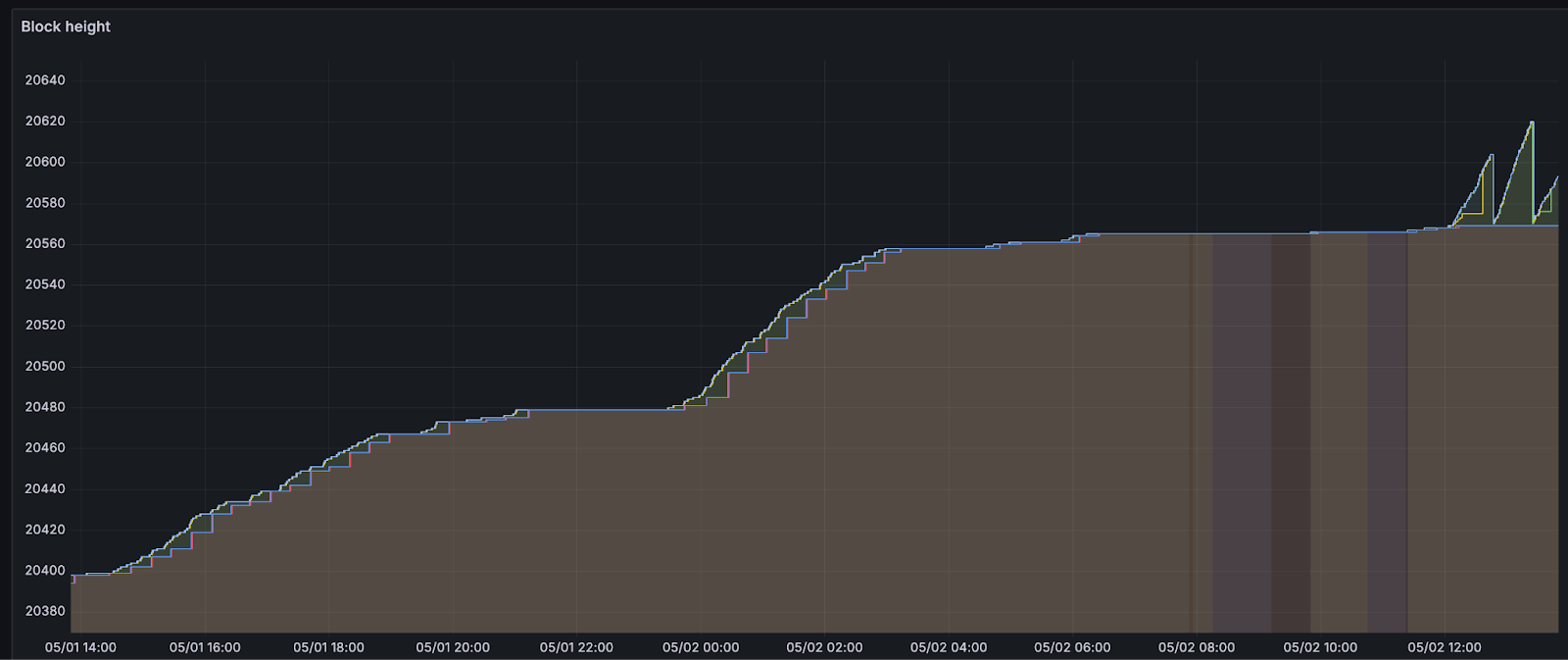
Around 6 hours after announcing the network launch, more than 150 sequencers had joined the validator set to sequence transactions and propose blocks for the network. 500+ additional full nodes were spun up by node operators participating in our Discord community. These sequencers were flooded with over 5k transactions before block production slowed. Let’s dive into why block production slowed down.
On Aztec, an epoch is a group of 32 blocks that are rolled up for settlement on Ethereum. Leading up to the slowdown of block production, there were entire epochs with full blocks (8 transactions, or 0.2TPS) in every slot. The sequencers were building blocks and absorbing the demand for blockspace from users of the Aztec playground, and there was a build up of 100s of pending transactions in sequencer mempools.
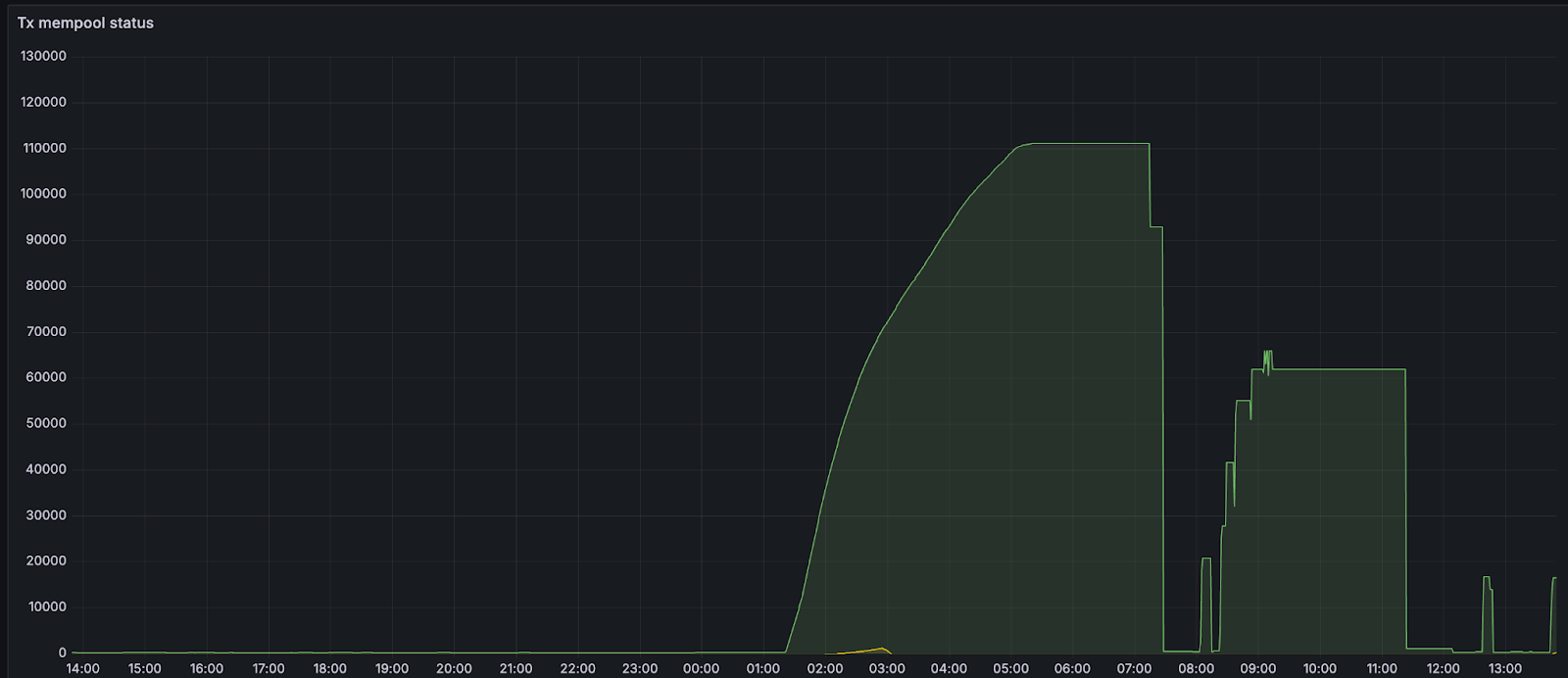
Issues arose when these transactions started to exceed the mempool size, which was configured to hold only 100mb or about 700 transactions.
As many new validators were brought through the funnel and started to come online, the mempools of existing validators (already full at 700 transactions) and new ones (at 0 transactions) diverged significantly. When earlier validators proposed blocks, newer validators didn't have the transactions and could not attest to blocks because the request/response protocol wasn't aggressive enough. When newer validators made proposals, earlier validators didn't have transactions (their mempools were full), so they could not attest to blocks.
New validators then started to build up pending transactions. When validators with full mempools requested missing transactions from peers, they would evict existing transactions from their mempools (mempool is at max memory) based on priority fee. All transactions had default fee settings, so validators were randomly ejecting transactions and were not doing so in lockstep (different validators ejected different transactions). For a little over an hour, the mempools diverged significantly from each other, and block production slowed down to about 20% of the expected rate.
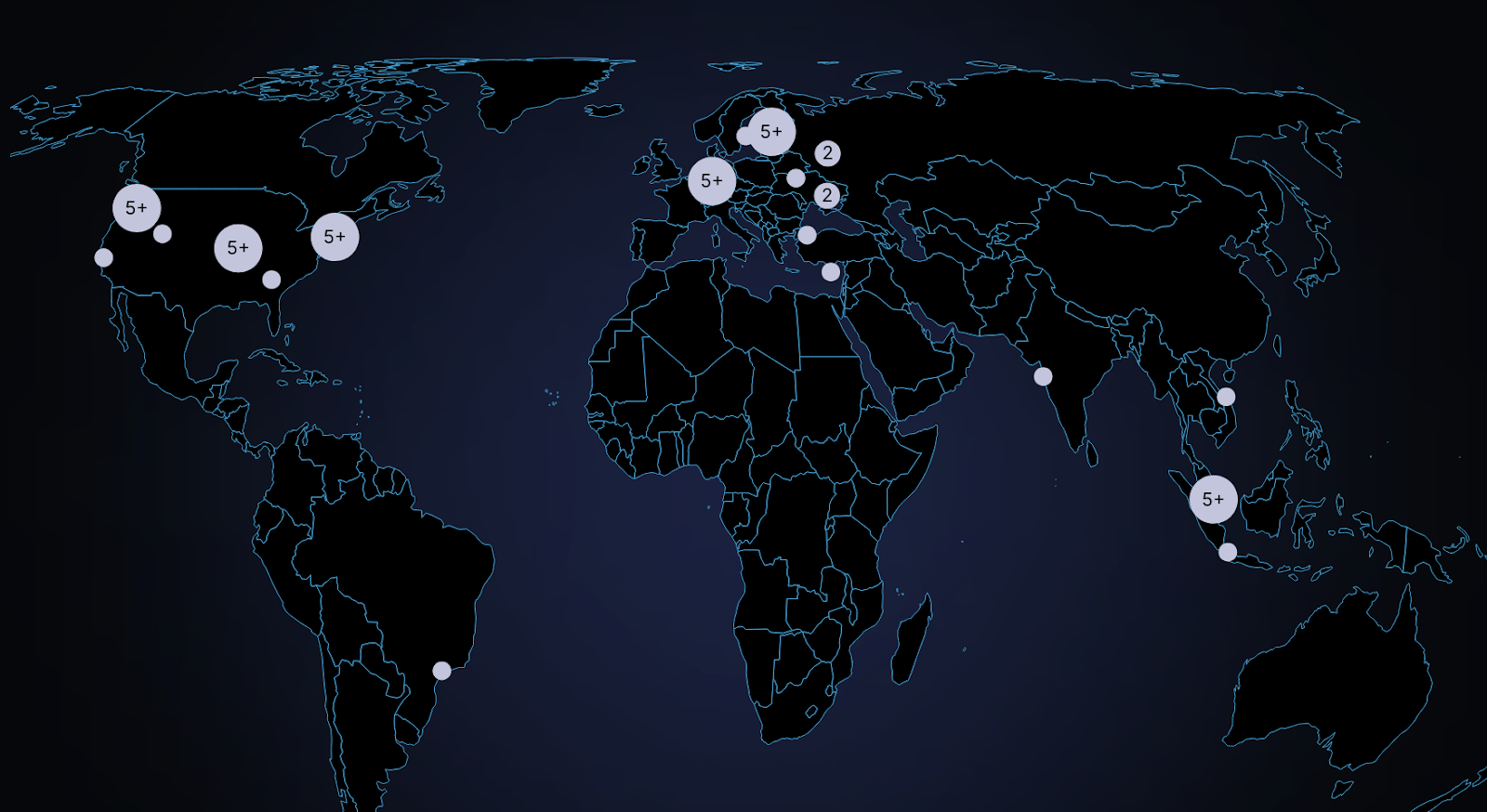
In order to stop the mempool from ejecting transactions, the p2p mempool size was increased. By increasing the mempool size, the likelihood of needing to evict transactions that might soon appear in proposals is reduced. This increases the chances that sequencers already have the necessary transactions locally when they receive a block proposal. As a result, more validators are able to attest to proposals, allowing blocks to be finalized more reliably. Once blocks are included on L1, their transactions are evicted from the mempool. So over time, as more blocks are finalized and transactions are mined, the mempool naturally shrinks and the network will recover on its own.
If you are interested in running a sequencer node visit the sequencer page. Stay up-to-date on Noir and Aztec by following Noir and Aztec on X.
Special thanks to Palla, James Zaki, and Emmanuel Batse for the review.
Disclaimer: if you’re familiar with Account Abstraction and are curious about how it works on Aztec, go right to the section “The most abstract Account Abstraction”.
Account Abstraction context
What is AA and why did the Ethereum community give it this name?
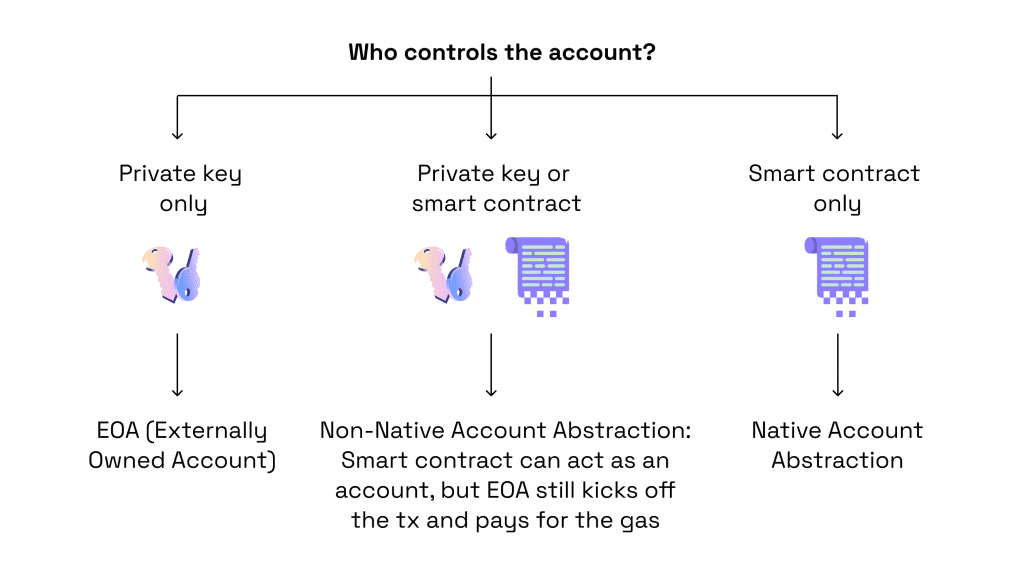
Note: the second option is sometimes also referred to as “contract wallets” or “smart accounts”.
The story of Account Abstraction
AA on Ethereum
The discussions around AA on Ethereum started around 2017. There were a number of EIPs and ERCs proposing different versions of AA (e.g. EIP-86, suggesting abstraction of transaction origin and signature, EIP-1014, and EIP-2938) that were explored and discussed but ultimately rejected, so we won’t cover them in this piece.
The first ERC affiliated with AA that made it to Ethereum mainnet was ERC-4337 (deployed on Mainnet in March 2023). It introduced AA without any modifications to the core protocol. It achieved this by replicating the functionality of the transactions mempool in a higher-level system. Instead of transactions, users send UserOperation objects to relayers, and these relayers package a set of these objects into a single standard transaction that is sent to Ethereum nodes.
Since then, the community has argued whether ERC-4337 is the Ethereum AA endgame or not. Right now, there is a dispute around EIP-3074 in the next Ethereum protocol upgrade. It suggests AUTH and AUTHCALL opcodes, which allow EOAs to delegate execution to smart contracts. However, one should note that the transaction validity still relies on EOAs’ ECDSA signature (i.e. ECDSA signature becomes enshrined).
This EIP is not new and some ecosystem players have discussed it being complementary to ERC-4337. The core question is what’s the more urgent problem for Ethereum to solve – censorship-resistance (against EIP-3074) or user experience (for EIP-3074)?
As Ethereum follows the rollup-centric roadmap, we expect most activity to happen on Ethereum L2s. As L2s technically don’t depend on Ethereum, they can implement AA on their own by introducing appropriate opcodes.
Some L2s have chosen a native AA “feature” as one of their core value propositions and implemented native AA (among those zkSync, StarkNet, and Aztec). In particular, this means that a transaction can be initiated directly by a smart contract (i.e. without any reliance on EOA).
As a comparison, in ERC-4337, AA is not native, as there is a step in the tx flow where an EOA account is engaged (as a Bundler).
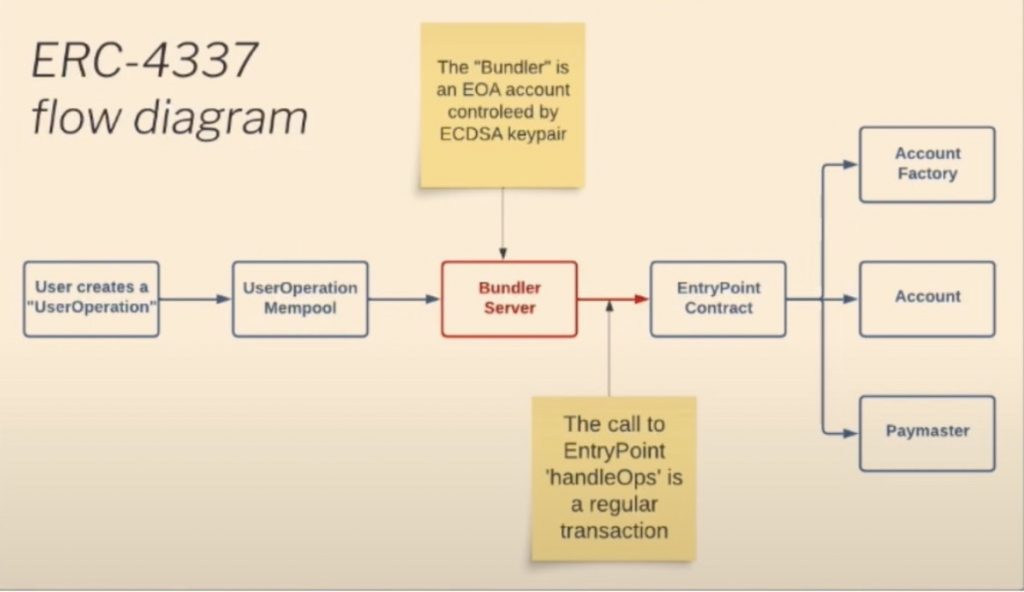
As an alternative to enshrining AA in Ethereum, the Rollup Improvement Proposal (RIP) was proposed. RIP is a way to facilitate L2 standardization (not only around AA but around other L2 aspects as well). RIP-7560 is a native version of ERC-4337 for L2 chains currently under discussion. Check a series of RollCalls to learn more.
The most abstract Account Abstraction
While we talk about “arbitrary verification logic” describing the intuition behind AA, the logic is not really arbitrary. The verification logic (i.e. what can be checked as an authorization) is limited to make the verification time fast and bounded. That is the case for all chains where transaction validity is checked by the sequencer. Otherwise, it will cause UX downfall, whereas the main reason behind introducing AA is UX improvement.
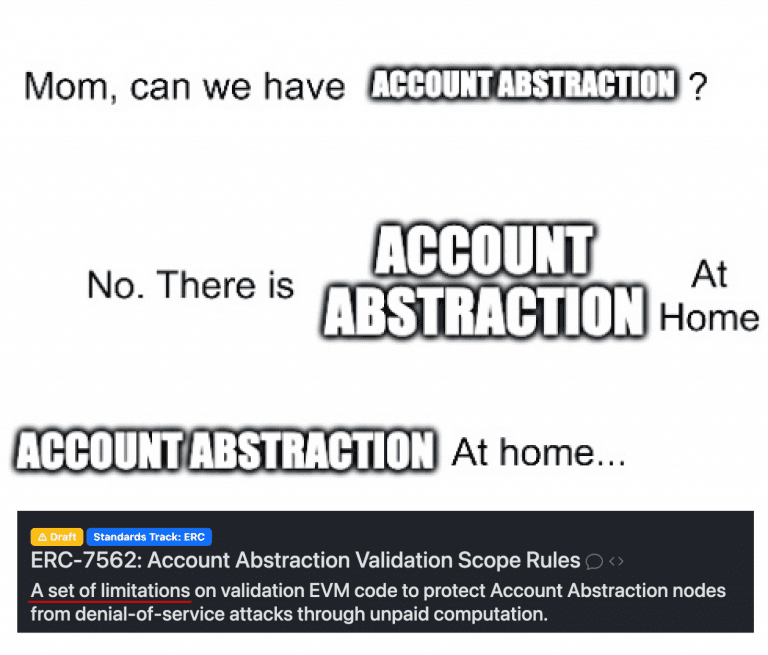
On Aztec, there is no limitation on verification logic, as transaction validity check is executed client-side and a proof of validity is supplied to the sequencer. The sequencer only verifies the proof and this process is independent of the verification logic complexity.
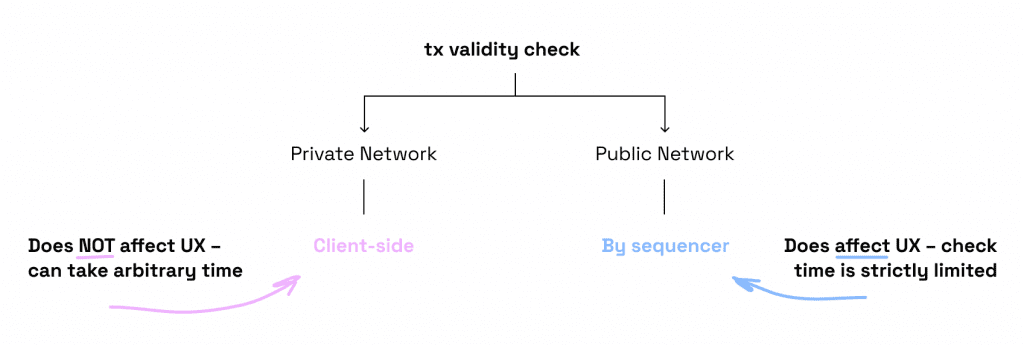
This unlocks a whole universe of new use cases and optimization of existing ones. Whenever the dapp can benefit from moving expensive computations off-chain, Aztec AA will provide a unique chance for an optimization. That is to say, on traditional chains users pay for each executed opcode, hence more complex operations (e.g. alternative signature verification) are quite expensive. In the case of Aztec, it can be moved off-chain so that it becomes almost free. The user pays for the operations in terms of client-side prover time.
For example:
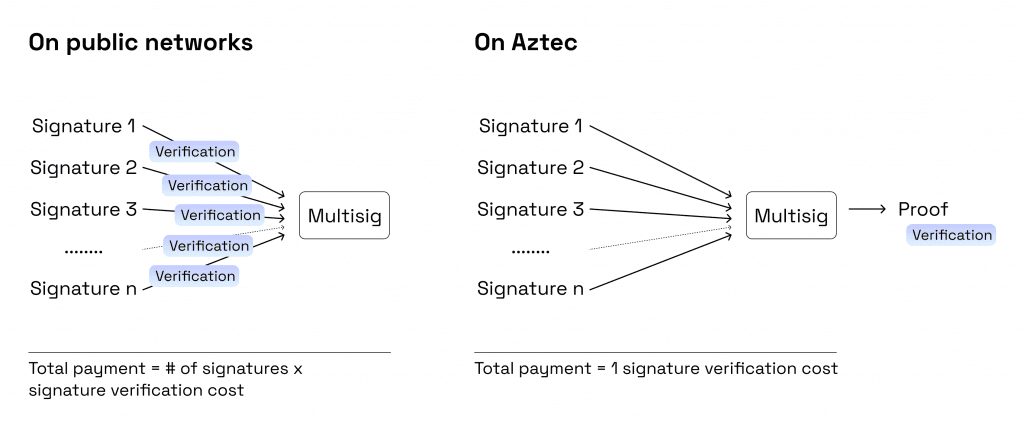
However, one should note that if the verification logic depends on the public state and requires a public function call (e.g. checking the balance), this check will be executed by the sequencer and imply some limitations on the allowed complexity of verification logic. For those who prefer watching over reading, here is a talk, “Account Abstraction for a Private Network”, by Santiago Palladino (Palla).ConclusionAA is not a new topic, however, AA on private networks unlocks new capabilities for arbitrary verification logic, allowing for more complex logic as well as significant cost optimizations. Check documentation to dive into the details of Aztec’s AA. And if you are up to join Aztec’s building pioneers – express your interest in this form. Sources
Aztec Labs is committed to enabling developers to build with ZK and unlock the full potential of this transformative technology. To that end, we built Noir, an open source Domain Specific Language for safe and seamless construction of privacy-preserving ZK proofs. We fund tooling, libraries, and applications that make Noir more accessible and enjoyable for developers.
Earlier this year, the Ethereum Foundation announced the first ZK Grants Round, a cofunded proactive grants round to encourage research and development for Zero-Knowledge proofs and standards for ZK L2s. Aztec Labs contributed US$150,000 to the US$900,000 prize pool alongside other projects such as Polygon, Scroll, Taiko, and zkSync. We sponsored this initiativeas a part of our commitment to support builders who are advancing ZK across dimensions including research, performance, tooling, and applications.
We were thrilled to see submissions to the ZK Grants Round from both new and existing Noir contributors. In this post, we want to highlight the ZK Grants Wave awardees for the Noir ecosystem to showcase what the community is working on and provide inspiration for how you could contribute.
Team: @eryxcoop, @manastech
Noir is back-end agnostic and its Arithmetic Circuit Intermediate Representation (ACIR) can be integrated with different proving backends. This project will enable Noir users to prove and verify their programs with Plonky2 technology, unlocking more possibilities to develop blockchain and ZK infrastructure with Noir. Meanwhile, it will also allow Plonky2 users to benefit from Noir’s developer-friendly abstractions, tooling, and growing sets of libraries, lowering the barrier of entry to the proving technology.
Team: @schaliasosvons, @theosotir
Noir abstracts away underlying cryptography so it’s accessible to a broader developer base. However, one risk of these abstractions is unintentionally leaking private variable information. This tool will apply static analysis, taint tracking, input generation, and SMT solving to detect privacy leaks in Noir program designs. Noir users can leverage this easy to use framework and debugging tool to identify, analyze and amend such leakages in their projects.
Team: @wz__ht
Performance benchmarking varies across different languages and proving systems. This project aims to produce benchmarking suites, articles, and a website that compares and informs developers about characteristics, performance, and tradeoffs between Noir-compatible and other proving backends in the ZK ecosystem.
Team: @wz__ht
Noir reduces barriers for developers to use ZK with its simple and familiar Rust-like syntax. But a solid developer experience is more than just language design. It also depends on a strong ecosystem of developer tooling. This project will offer treesitter grammars that unlock features like syntax highlighting and code formatting for the language in more development environments like Helix and Neovim – providing Noir developers with more flexibility and choice.
Team: Neoxham, Lakonema2000, @0x18a6
Noir tooling and libraries are created to support and enable application developers who solve problems using ZK. This team will leverage Noir to create an educational end-to-end example of verifiable Know Your Customer (KYC) with compliance checks, and provide onboarding guides to increase adoption of the application.
We are grateful to the Ethereum Foundation for coordinating the ZK Grants Round and to the teams who submitted proposals. We look forward to seeing how the Noir community leverages these tools and resources to build the next wave of ZK powered applications.
If you’d like to learn more about Noir, read our docs and follow @NoirLang for more contribution opportunities coming soon.
The proof generation for a privacy-preserving zk-rollup differs a lot from that of a general-purpose zk-rollup. The reason for this is that there is specific data in a given transaction (processed by private functions) that we want to stay completely private. In this article, we explore the client-side proof generation used for proving private functions’ correct execution and explain how it differs from proof generation in general-purpose rollups.
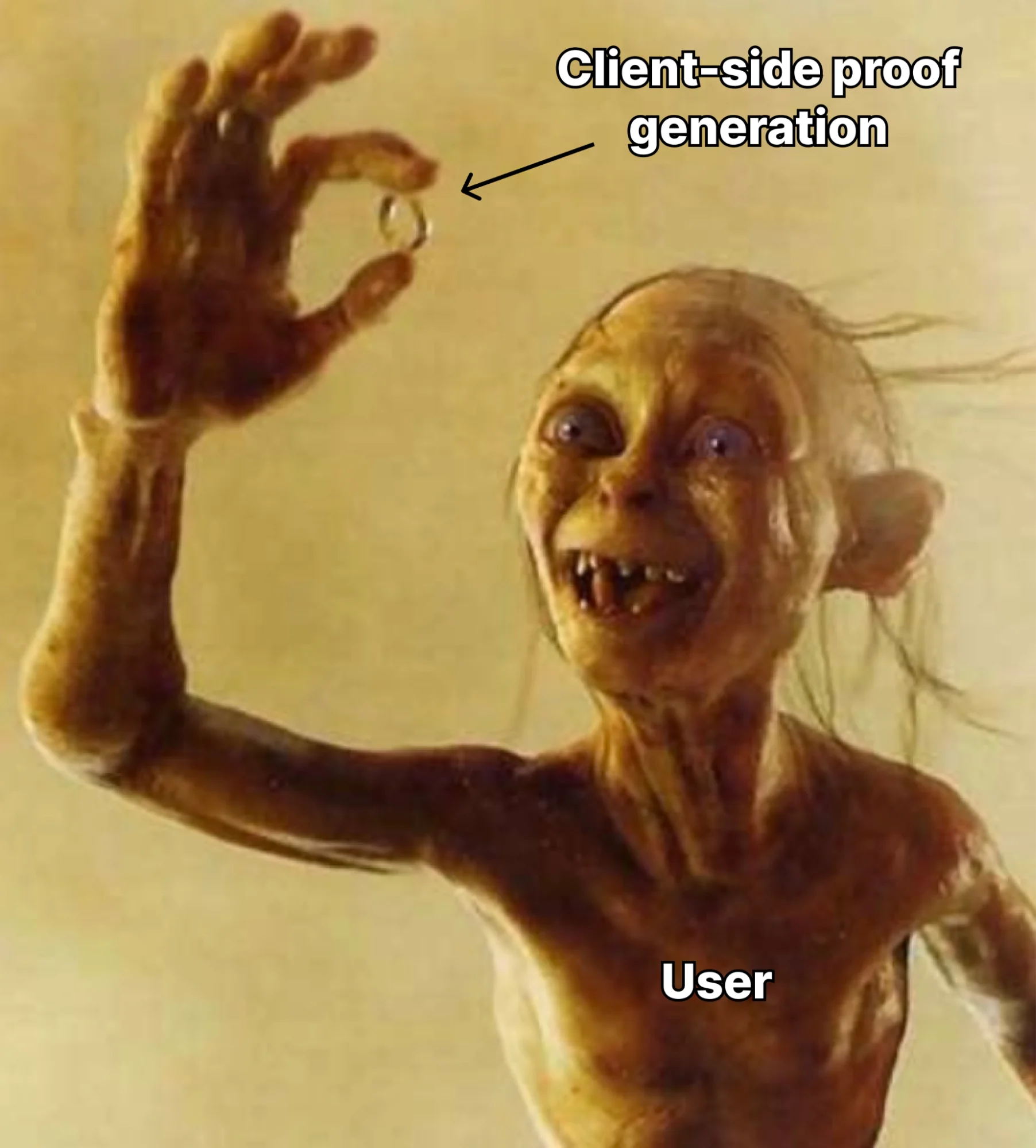
Contents
Disclaimer: If you’re closely familiar with how zk-rollups work, feel free to skip this section.
Before we dive into proofs on Aztec, specifically the privacy-first nature of Aztec’s zk-rollup, let’s recap how proofs work on general-purpose zk-rollups.
When a stateful blockchain executes transactions, it conducts a state transition. If the state of the network was originally A, then a set of transactions (a block) is executed on the network, the state of the network is now B.
Rollups are stateful blockchains as well. They use proofs to ensure that the state transition was executed correctly. The proof is generated and verified for every block. All proofs are posted on L1, and anyone can re-verify them to ensure that the state transition was done correctly.
For a general-purpose zk-rollup, proof generation is very straightforward, as all data is public. Both the sequencer and the prover see all the transaction data, public states are public, and the data necessary to reconstruct each state transition is posted on L1.
Aztec’s zk-rollups are a different story. As we mentioned in the previous article, in the Aztec network, there are two types of state: public and private.
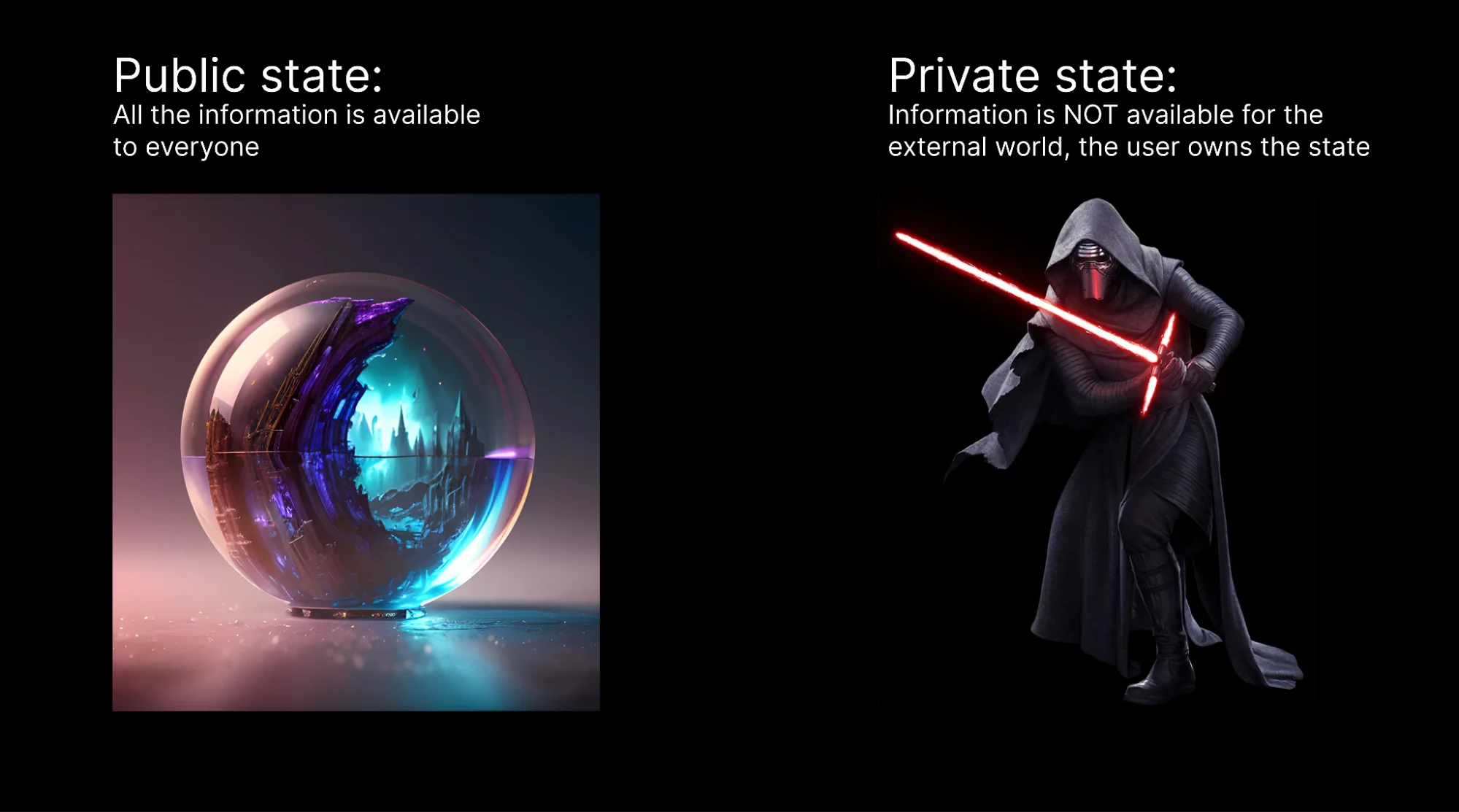
Aztec smart contracts (written in Noir) are composed of two types of functions: private and public.
For both of these, we need proof of correct execution. However, as the anatomy of private and public functions is pretty different, their proof generation is pretty different too.
As a brief overview of how Aztec smart contracts are executed: first, all private functions are executed and then all public functions are executed.
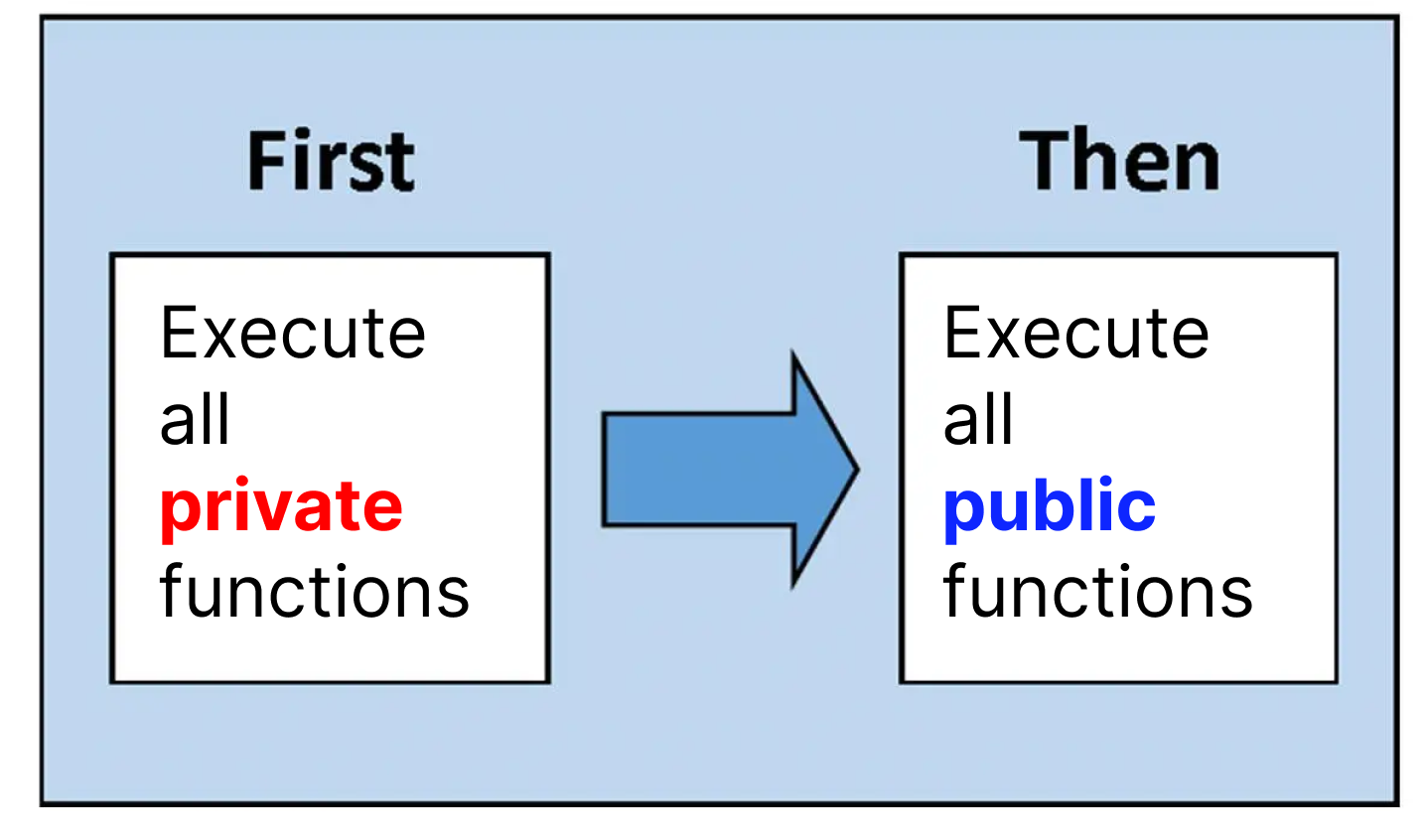
However, diving into the anatomy of Aztec smart contracts is outside the scope of this piece. To learn more about it, check the previous article.
Here, we will focus on the correct proof generation execution of private functions and why it is a crucial element of a privacy-first zk-rollup.
The concepts of private state and private functions in blockchain might seem a little unusual. The following map describes the path of this article, where we will shed some light on the difference between how proofs work for private and public states respectively.
Let’s start by looking at public function execution, as it is more similar to other general-purpose zk-rollups.
Public state is the global state available to everyone. The sequencer executes public functions, while the prover generates the correct execution proof. In particular, the last step means that the function (written in Noir) is compiled in a specific type of program representation, which is then evaluated by a virtual machine (VM) circuit. Evaluated means that it will execute the set of instructions one by one, resulting in either a proof of correct execution or failure. The rollup-side prover can handle heavy computation as it is run on powerful hardware (i.e. not a smartphone or a computer browser as in the client-side case).
Private state on the other hand is owned by users. When generating proof of a private transaction's correct execution, we want all data to stay private. It means we can’t have a third-party prover (as in the case of public state) because data would be subsequently exposed to the prover and thus no longer be private.
In the case of a private transaction, the transaction owner (the only one who is aware of the transaction data) should generate the proof on their own. That is, the proof of a private transaction's correct execution has to be generated client-side.
That means that every Aztec network user should be able to generate a proof on their smartphone or laptop browser. Furthermore, as an Aztec smart contract might be composed of a number of private functions, every Aztec network user should be able to generate a number of proofs (one proof for each private function).
On the rollup side, block proofs are generated using ZK-VM (ZK virtual machine). On the private side, there is no VM.

Instead, each private function is compiled into a static circuit on its own.
When we say “a circuit”, we’re referring to a table with some precomputed values filled in. This table describes the sequence of instructions (like MUL and ADD) to be executed during a particular run of the code.
There are a bunch of predefined relations between the rows and columns of the table, for example, copy constraints that state that the values of a number of wires are expected to be the same.
Let’s take a look at a quick example:
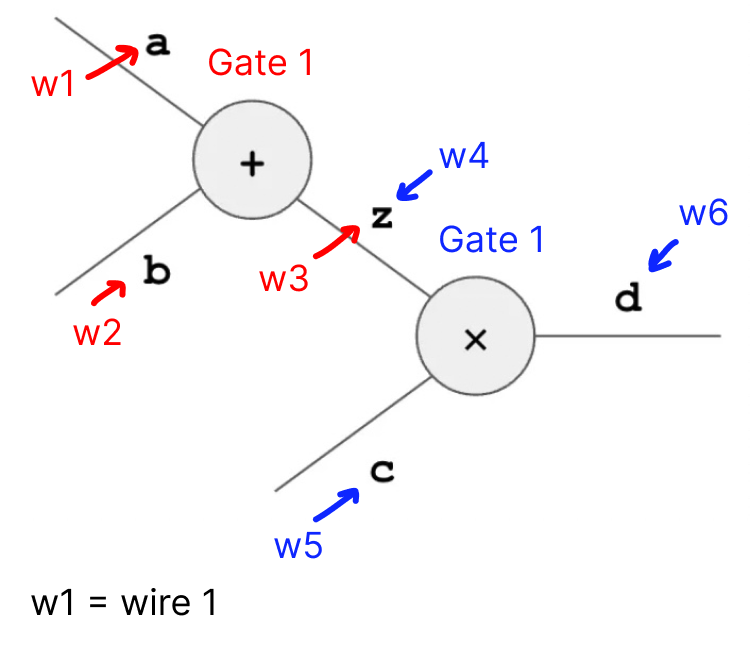
In the diagram above, we have two gates, Gate 1 (+) and Gate 2 (x). As we can see, z is both the output of Gate 1 (denoted as w3, wire 3) and the left input to Gate 2 (denoted as w4, wire 4). So, we need to ensure that the value of the output of Gate 1 is the same as the value of the left input of Gate 2. That is, that w3 = w4. That’s exactly what we call “checking copy constraints”.
When we say that the verifier verifies the circuit, we mean it checks that these predefined relations hold for all rows and columns.
Disclaimer: the following example reflects the general logic in a simplified way. The real functions are much more complex.
Assume we have a function a2+b2=c2. The goal is to prove that equality holds for specific inputs and outputs. Assume a = 3, b = 4, c = 5.
As a piece of code, we can represent the function as the following:
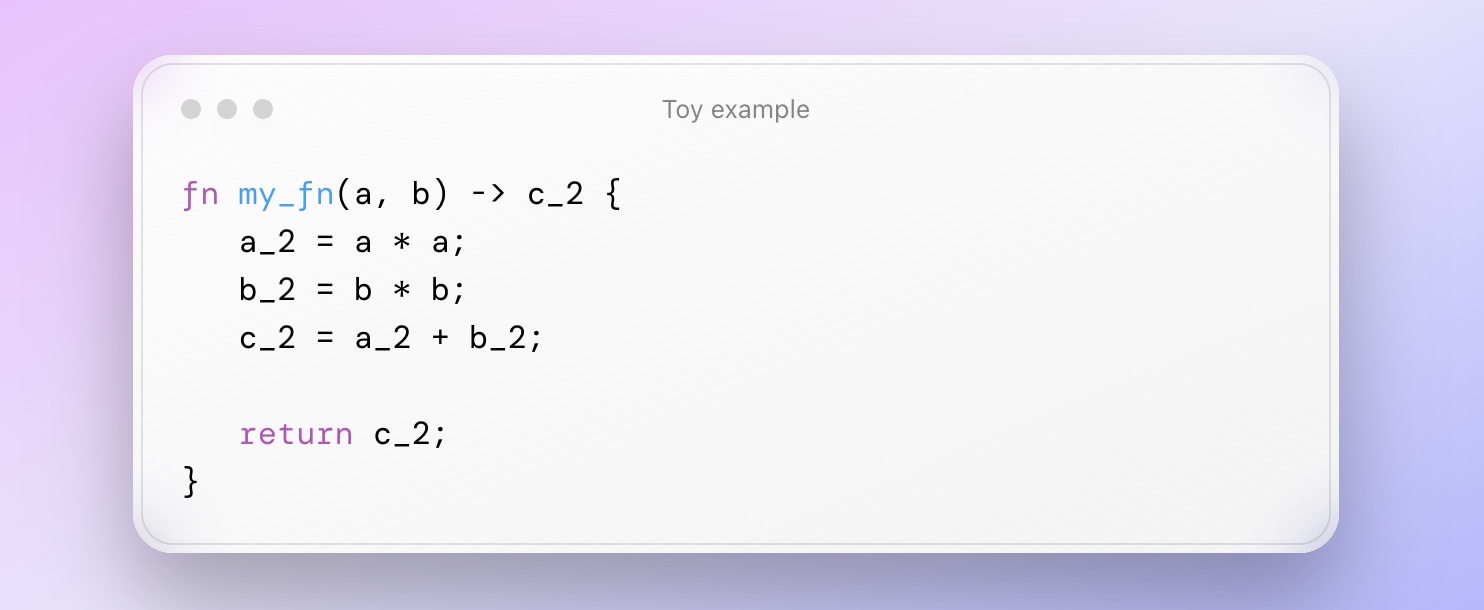
When the function is executed, the result of each step is written down in a table. When this table is filled with the results of the specific function execution on specific values, it’s called an execution trace.

This is just a fragment of the table, with values and opcode names. However, to instruct the computer about which operation should be executed in which specific row, the opcode name is not enough; we need selectors.
Selectors are gates that refer to toggling operations (like an on/off switch). In our example, we will use a simplified Plonk equation with two selectors: qADD for the addition gate and qMUL for the multiplication gate. The simplified Plonk equation is: qMUL(a*b)+qADD(a+b)-c=0.
Turning them on and off, that is, assigning values 1 and 0, the equation will transform into different operations. For example, to perform the addition of a and b, we put qADD= 1, qMUL=0, so the equation is a+b-c =0.
So, for each performed operation, we also store in the table its selectors:

In the case of private functions, as each function is compiled into a static circuit, all the required selectors are put into the table in advance. In particular, when the smart contract function is compiled, it outputs a verification key containing a set of selectors.
In the case of a smart contract, the circuit is orders of magnitude larger as it contains more columns with selectors for public function execution. Furthermore, there are more relation checks to be done. For example, one needs to check that the smart contract bytecode really does what it is expected to do (that is, that the turned selectors are turned according to the provided bytecode commitment).

As a mental model, you can think about a smart contract circuit as a table where 50 out of 70 columns are reserved for the selectors' lookup table. Storing the entire table requires a lot of memory.
Now you see the difference between circuit size for client-side and rollup-side proof generation: on the client-side, circuits are much smaller with lower memory and compute requirements. This is one of the key reasons why the proofs of private functions' correct execution can be generated on users’ devices.
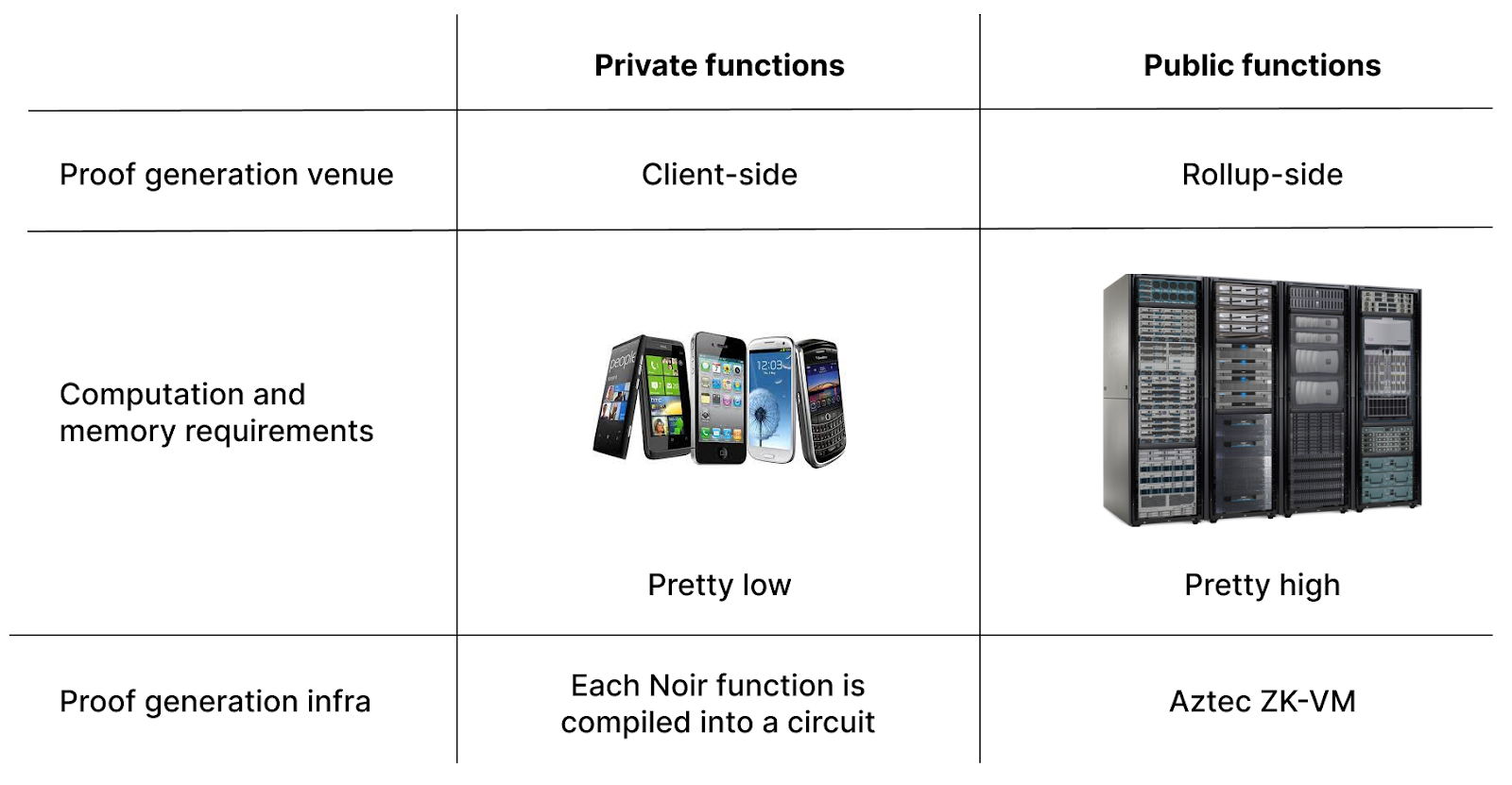
Client-side proof generation is a pretty novel approach for the blockchain domain. However, for privacy-preserving solutions, it is an absolute must-have. Aztec Labs has spent years developing the protocol and cryptography architecture that make client-side proof generation performance feasible for the production stage.
You can help build it further.
The following is written by Zac Williamson, with inspiration and advice from Arnaud Schenk.
My fellow companions, my decentralized brothers and sisters. I wish to tell you a story, about complicated people and their struggles to resolve the wreckage of their contradictions. It is a story of humanity.
We are at a unique point in history and stand at the threshold of two worlds. One world is a propagation of our present, a status quo antebellum with all of its associated joys and sorrows.
There is another door, one hidden from view except for those with the sight to see it. You and I are here because we see a unique vision of the future, one of high technology and high ideals, that advance human beings from their status as a commodity resource in a globalized world, to free actors imbued with autonomy and purpose, who bow to no one.
I want to articulate this vision and examine the forces that drive us. Despite our successes and dedication it is clear that our current achievements fall short of our aspirations. We must reconcile this.
Bitcoin is not yet a credible threat to traditional currencies. Paying for goods and services with cryptocurrency is a niche luxury for the technologically well-connected. Decentralized autonomous organizations (DAOs) are yet to govern anything that is not a cryptocurrency project. A notable exception was ConstitutionDAO, which immediately failed in its goals due to the intrinsic limitations of trustless blockchain networks.
There are missing pieces in the technological armaments we have fashioned. I want to show you the missing pieces. I want to go back to the roots: what are the systems and frameworks we want to disrupt? Which properties do blockchain networks need for us to forge a conspiracy against the present, and fight for our vision of the future?
Reaching back into prehistory, humanity has been waging a war against itself – a war that pits the freedom and autonomy of individuals against the safety and control of institutions.
We want to be free. We want to be safe. This is the eternal contradiction.
To acquire safety we bind ourselves to institutions. Within these institutions, control factions form. They metastasize and act to entrench their power and influence by monopolizing human agency. This triggers inevitable conflict and revolt, which acts to reset the equilibrium.
How best we can resolve the contradiction between freedom and safety is a function of social organization, the quality of which is gated behind technological innovation.
Blockchain is one such technology. To identify what we need, we must identify the weaknesses of the institutions we seek to undermine, and tailor our strengths against them.
Control factions have a fatal weakness: they reject competence.
Competent people threaten individuals within entrenched power structures. A competent subordinate is a threat to your power and privileges. This is the so-called “dictator trap”, but the mechanics at play extend to all power structures, from the boards of mega-corporations to the local residents association. But it’s not a dictator trap, it is an institution trap.
Power craves legibility and predictability and will act on these desires by exerting control – limiting agency and freedom of action.
We want to undermine institutional control, and redistribute control down to smaller units of organization.
Blockchain technology enables such radical new forms of social organization that fall outside the frameworks of traditional institutions.
We possess a keystone technology that enables mass peer-to-peer coordination, initially of cryptocurrency assets but this can be generalized to anything with perceived value that can be given a digital fingerprint.
Blockchain networks have radically different incentive mechanisms to traditional modes of social organization.
Because blockchains are coordination engines. They enable individuals to coordinate on how to deploy their collective resources. This type of mass-coordination of personal resources is unique and will subtly act to profoundly re-distribute the existing power structures of the present.
Why? Blockchains weaken the fundamental value propositions of vertically integrated companies that extract a profit from information asymmetries. Individuals whose skills serve large institutions can more easily decide for themselves how best to apply their skills, without the need for the institution’s support frameworks. As a coordination engine, blockchain networks can efficiently combine the skills and capital required to execute grand ideas, as well as provide a digital market for resulting products.
A global marketplace of programmable money is one with profound information transparency. The ability of independent groups to analyze the market enables great efficiency and reduces information asymmetries. Though, does not delete them entirely.
In short, blockchain networks are pro-competency. They allow individuals to decide for themselves how their skills can best be utilized and deployed, instead of having that decided for them by a control faction. Competent people add value to the network and in doing so, provide another composable brick that others can use in their constructions. The raw incentives create a positive-sum game.
What are the missing pieces?
The great difficulty in realizing our vision is the limited ability of current blockchains to reach into the real world.
We are not our online avatars. We exist in a physical space and we have physical needs that must be satisfied. We are bound to networks of obligation and responsibility that societies depend upon to maintain social order. We cannot live in an NFT.
The real world matters. Without a way of linking real-world identities to blockchains, the grand cypherpunk vision for blockchain can never be fully realized – only a neutered form of primitive electronic sovereignty.
The new information networks we are building lack a key ingredient: composable privacy.
By using novel cryptography, we can turn blockchains into encrypted ledgers where transactions hide their execution from observers. Identities can be encrypted, but still used to prove statements about the user, and without involving an additional institutional third party. e.g. “I have a U.S. passport”, “I have a digital driving license”, “I have a Twitter account with over 1,000 followers”, “I signed in with a Google account”.
The effect of this is to build trust infrastructure that allows human beings to iteratively build trust between themselves and to do so rapidly and at scale.
Programmable private blockchains stand to usher in a revolution in how distributed systems can be used. Without strong identity guarantees, the only workable governance mechanisms for distributed on-chain organizations are autocracy and plutocracy.
However, if past actions can be uniquely tied to a cryptocurrency account, it is possible to identify key stakeholders and to give them an accelerated role in governance. That enables a much more democratic architecture of governance systems.
Privacy technology is required to turn blockchains into the coordination engines they were always destined to be.
The future we are building does not outright destroy existing systems of control – it breaks them apart and replicates these systems on a smaller scale. Lower barriers to entry lead to greater competition and market fragmentation and act to limit the ability of distributed organizations to consolidate power.
Because coordination engines are pro-competency.
There is a phrase I think we will hear much of over the coming years: privacy for the user, transparency for the protocol.
The capabilities of private programmable blockchains and the outcomes they enable are not commonly understood. A private blockchain is not one where all information and data are intrinsically hidden. They are hybrid systems where public and private data coexist. Application designers and users can choose which data is hidden.
Efficient markets require data transparency. Data relating to identity requires data confidentiality. The solution is applications where information that relates to assets is public, and information relating to users (e.g. who owns said assets) is private.
To create a privacy-preserving ecosystem it must be possible for confidential, transparent, and hybrid applications to directly interact with one another. Privacy is not an aftermarket add-on to be bolted onto a few select applications. Full composability is essential to develop a rich ecosystem.
Composability enables trust-building networks by allowing individuals to put core aspects of themselves on-chain, disclosing it only selectively and enabling distributed protocols to use these capabilities in a composable permissionless manner, without leaking information. Who are you? What have you done? What do you want to do? With privacy, we can disclose this information to smart contracts and hide it from people. These will form core primitives of our new information networks.
I have spent the last 6 years building exactly this, through building Aztec. Crafting the missing ingredient, privacy, via cutting-edge cryptography, zero-knowledge proofs, and raw engineering.
Networks have values that are independent of their creators. Networks live or die on the quality of their network effects. This incentive gives network participants a shared motivation to expand the network. The more nodes that exist, the greater the value individual nodes can extract from the network. The manner in which the network changes itself to act on these motivations defines its intrinsic values.
What are the intrinsic values of permissionless programmable privacy networks like Aztec? We can derive these from the fundamental value proposition – to expose a rich ecosystem of composable, confidential applications, and to do this as a permissionless, decentralized network. This enables individuals and small groups to compete in industries dominated by large players leveraging large information asymmetries.
Such networks are, at their very core, pro-competency. If you have something useful to add to the network, you can. If you want to use existing network components in your product, go right ahead. No need to ask for permission from the network.
From this starting point we can anticipate the cycles of action and reaction that will drive networks like Aztec to adopt the following values over their lives:
Blockchain networks grow by harnessing the industry and enterprise of as many human souls as they can get their hands on.
Without mechanisms of coercion to fall back on, the network must ensure a positive-sum game for network participants who add value. These also happen to be values that I believe I strongly hold. This is not a coincidence. I started in web3 seven years ago building a marketplace for corporate debt on Ethereum and by degrees ended up building a distributed programmable privacy network on Ethereum. This was not due to some grand design but, I think, the cumulative effects of seven years of following my impulses. To find a place of belonging.
This feeling is something you may share – that the frameworks and systems produced by our societies offer none of us a true sense of belonging and purpose. But here, amongst our companions, we have found belonging through building a shared vision of a radical new world.
There is a long road to walk to realize the ambitions of the new information networks. The technology is barely capable and challenging to build. The architecture is novel and challenging to design. Convincing people to build on radical foundations to bootstrap a market is challenging. Building competitive infrastructure and tooling is challenging.
The challenge is irrelevant. We cannot become a generation scorned by our descendants for squandering the opportunity of a lifetime.
We will build and deploy the new information networks and by degrees will learn how to use them to chip away at the inequities of the status quo, and the social order that upholds it.
Equipped with such armaments and driven by our ideals, we will pull our ideas into reality. Together, we will forge our digital Eden.